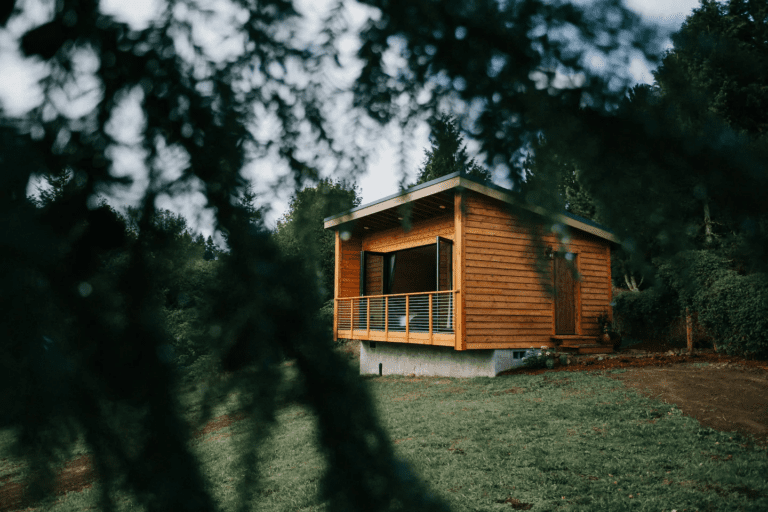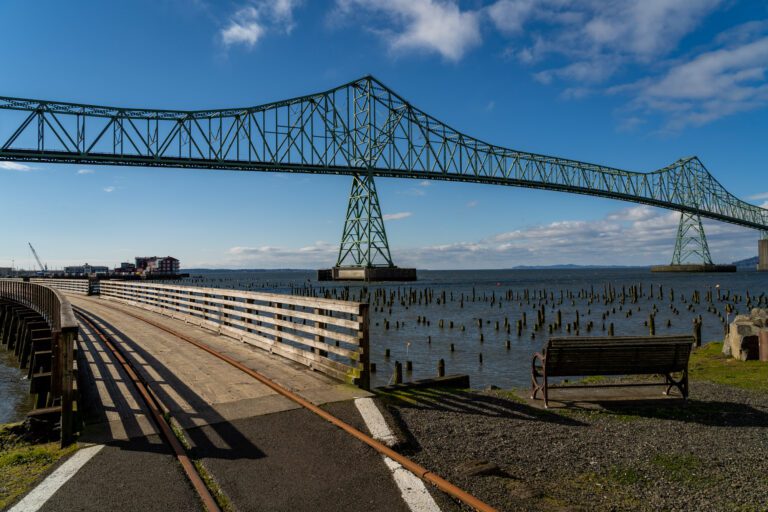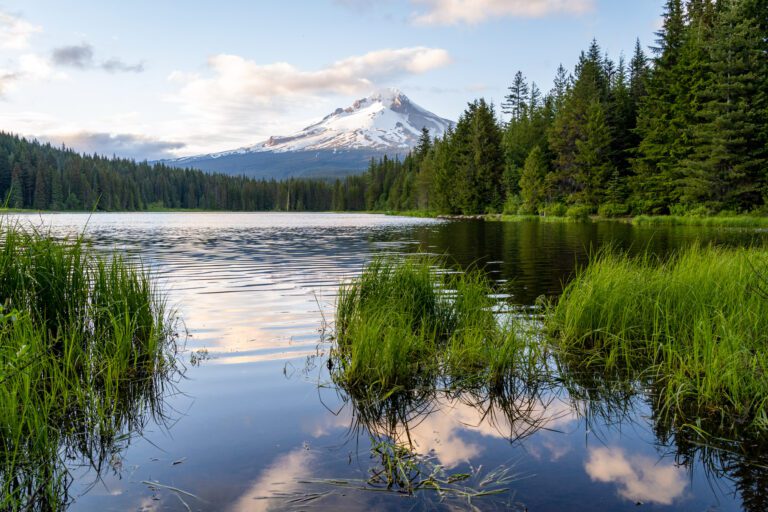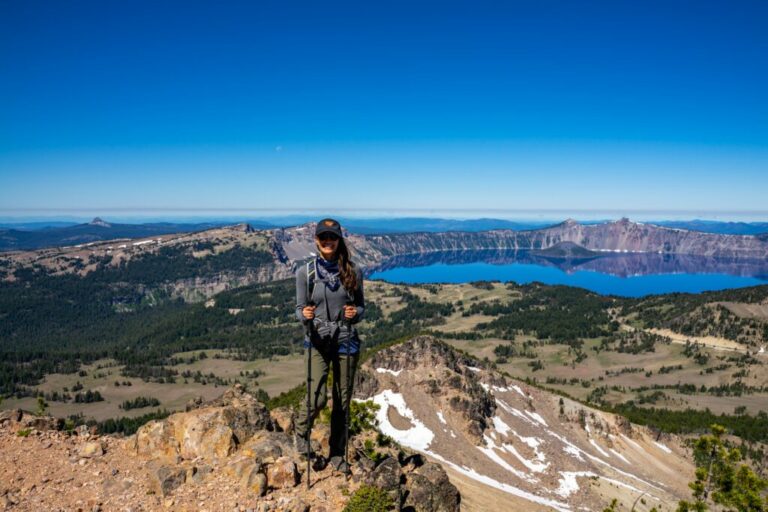Exactly How to Plan an Incredible Oregon Coast Road Trip
Looking to plan a road trip down the Oregon Coast? You’re in the right place! We’ve done this drive three or four times now (Matt’s family lives in Seattle, Alysha’s lives in California, and we drive the coast to avoid the snow in the Siskyous), and seem to discover something new on each foray down the wild stretch of coast that calls Oregon home. And we’re here to do our best to help you plan an amazing Oregon Coast road trip!
The Oregon Coast is one of the most gorgeous pieces of the Pacific Northwest, and that’s saying something considering the Northwest is full of incredible natural beauty. Huge groves of towering sitka spruce trees, a coastline of beaches that oscillate between wide and sandy and rocky and full of sea stacks, and plenty of great food and hiking along the way.
Basically, a drive down the Oregon Coast has everything we love on a road trip.
Despite being sandwiched between our two home states of Washington and California, Oregon was a place that largely remained a mystery to us outside of Portland, which has been in the pantheon of our favorite cities in the world for many years now.
That is, until we had to reevaluate our travel plans in early 2020 (when we had concocted an entire year of international travel that we got six weeks into before having to cancel everything).
The Oregon Coast was our first destination on our on-and-off two year US road trip, and we ended up spending a leisurely two weeks in the early summer camping our way up the Oregon Coast from the south end, which we absolutely fell in love with, all the way up to Astoria at the northern tip of Oregon.
Over the past few years, we’ve also made an annual Seattle to San Francisco road trip to get between our families, and we drive some portion of the Oregon Coast to do it.
On our last trip – right before we made the move to Oregon – we spent another two weeks on the Oregon Coast, this time in the winter, making our way north to south.
In this (very long) guide, we’re going to do our best to give you everything – and we do mean everything – we think you’ll need to plan an amazing Oregon Coast road trip. From the best stops to make and what to do and see at each stop, to where to stay and how to put it all together, we’ve compiled everything we know about driving the Oregon Coast in this guide.
Ready to get planning? Let’s do it!
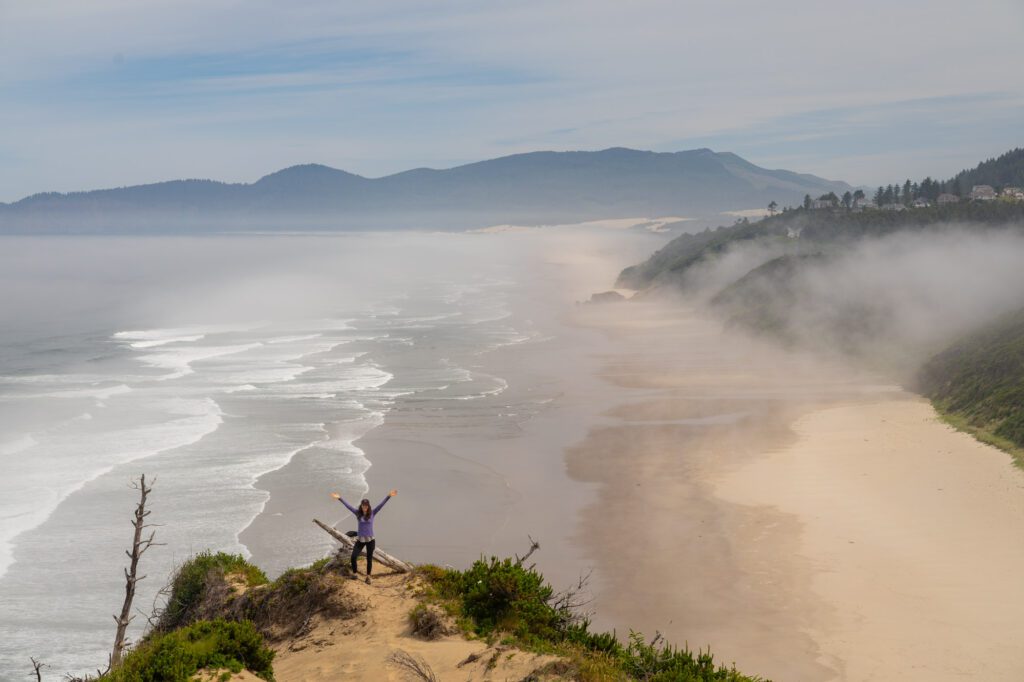

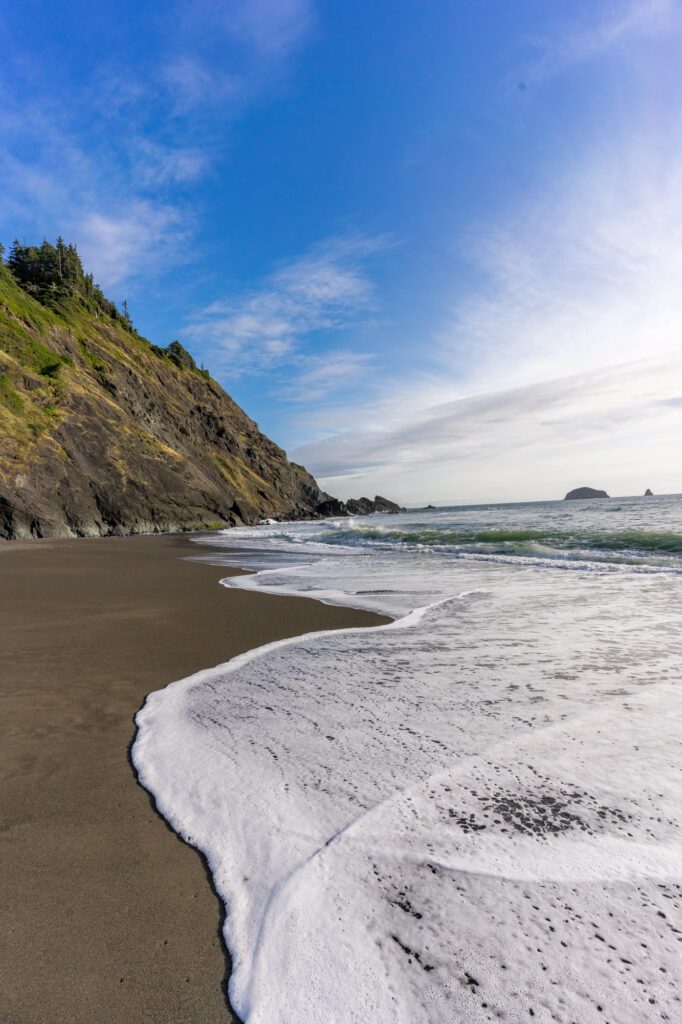
Disclaimer: Some of the links in this post, like hotel and vacation rental links, are affiliate links, meaning at no additional cost to you we make a little bit of money if you click through and book. That being said, we would absolutely never recommend something to you that we don’t stand behind 100%.
How Many Days Do You Need / Have on the Oregon Coast?
On both of our trips up and down the Oregon Coast, we’ve spent more than 10 days, taking it slow and soaking it all in.
However, we recognize that not everyone has the luxury of time, which is why we’re going to give you a day-by-day itinerary for different shorter time frames below the main guide to help you plan out a shorter trip if you have less time.
Here’s a high-level overview of what we’d do with three, five, and seven days or more on the Oregon Coast. For more detail, scroll down to the section below the best stops to see exactly how we’d plan a trip of various lengths.
With 3 Days
With three days, you really don’t have the time to drive the Oregon Coast in its entirety.
HOWEVER, you can do a pretty sweet road trip starting and ending in Portland that heads out to the northern Oregon Coast and takes in Astoria, Cannon Beach, and Tillamook before making your way back to Portland.
That’s how we’d spend your time, and you have the luxury of either choosing one home base (if you go that route, we’d stay in Astoria or Cannon Beach) or making your way from town to town.
With 5 Days
With five days, you really still only have time for the northern half of the Oregon Coast. Keep in mind, the drive from Brookings, the last town at the southern end of the coast, back to Portland will take you about six hours, give or take a half hour.
However, we think you have enough time to do the stretch from Astoria down to Newport, though it won’t be as slow-going as if you had more time.
If you’re looking for a slower pace, stake a home base in Cannon Beach or Tillamook and explore the stretch from Astoria to Lincoln City from there.
With 7 Days or More
If you have a week or more, you can probably do the whole coast (though with seven days, you’ll have to do some picking and choosing what exactly you want to see).
Start in Astoria and make your way all the way to Brookings, but make sure to plan for an extra day to get back to Portland from there!
In general, the northern Oregon Coast (roughly Astoria to Newport) is more developed and, for lack of a better word, “touristy,” while the southern Oregon Coast is more wild and rugged.
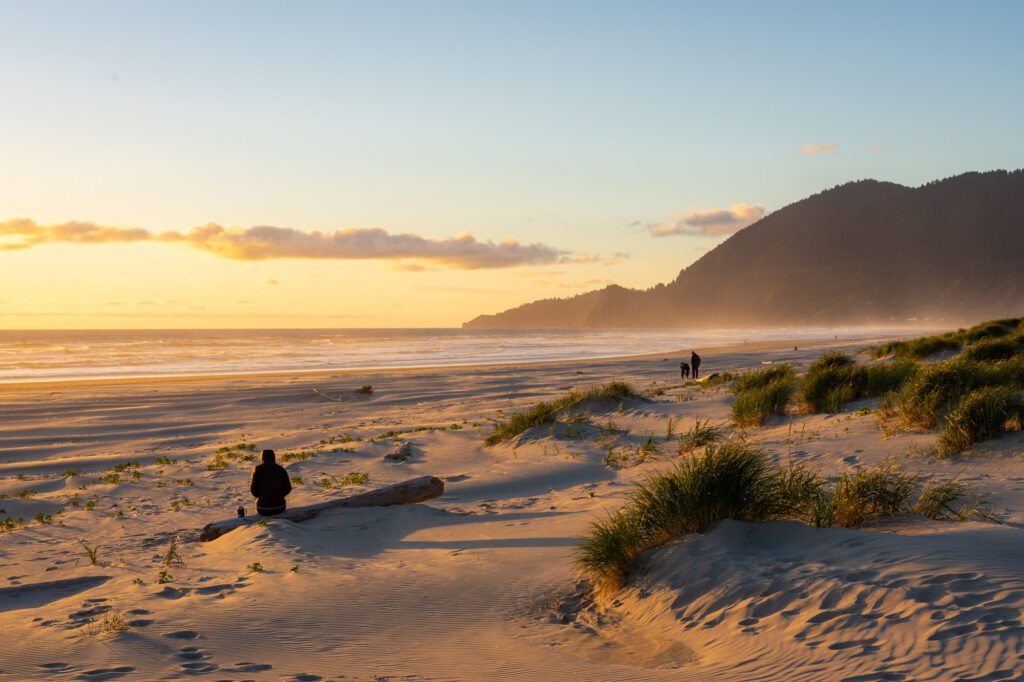
Where to Start and End Your Road Trip
The answer to this question depends on where you’re coming from, but for most people the answer is Portland, Oregon.
Portland is by far the easiest city to fly into in Oregon – Portland International Airport (PDX) is also known for being one of the most pleasant airports in the country – has the best rental car options and prices, and is a lovey place to spend some time on either end of your road trip (read our guide to a weekend in Portland, or one day in Portland for our take on the best way to spend your time).
Now, Portland isn’t technically on the Oregon Coast – it’s about two hours away. The Oregon Coast runs from Astoria at the northwestern tip of Oregon just across the Columbia River from my home state of Washington, down to Brookings at the California border (Alysha’s home state).
Tips for Driving the Oregon Coast
Here are a few things to know about the Oregon Coast before we get into the specifics.
There’s No Doubt About it – You Need a Car
Spoiler: you’ll need a car to do this road trip. If you’re flying in, you’ll have to rent a car in Portland when you arrive.
There’s no great way to use public transportation to get from the airport to the Oregon Coast, and there’s even fewer options connecting the various towns and parks once you’re actually on the coast.
You need to rent a car (or bring your own). The end.
Do Your Oregon Coast Road Trip North to South (If You Have the Choice)
We’ve done this road trip from north to south and south to north, and starting at the northern end and making your way south is undoubtedly easier because all of the coastal stops will be on the right hand side of the road, which means you don’t have to cross traffic to get to them.
That being said, it’s not a deal breaker – we went in the opposite direction on our first trip and it was barely noticeable. However, it is a consideration, and it’s why we organized this Oregon Coast itinerary from north to south.
Try to Stay in Places for Multiple Nights (If You Can)
We think you should – as much as your itinerary allows it – choose a home base for a few days and use it to explore a part of the coast rather than trying to stay in a different place each night, which is exhausting.
Plus, it’s easier to not have to juggle check-in times.
For example, on the northern Oregon Coast we’d recommend spending two nights in Cannon Beach and using them to visit Cannon Beach, Oswald West State Park, Ecola State Park, and even Astoria before moving south.
Passes and Permits for Driving the Oregon Coast
There are a couple of passes and permits you’ll need to park at various spots on the coast.
If you’re not an Oregon or Washington resident, then the best bet is to grab an Oregon Pacific Coast Passport, which covers a bunch of the stops on this list (you can see what is included on this page). It’s $10 for a 5 day pass, or $35 for an annual pass (if you’re going to be on the coast for more than 5 days, buy the annual pass).
You can purchase them at all Oregon State Parks and National Forest Service offices on the coast.
If you’re an Oregon resident, an Oregon State Parks Pass and a Northwest Forest Pass (or an America the Beautiful Pass) will get you into most of the spots here, and are good for the rest of the state / region too.
We have an Oregon State Parks Pass and have an America the Beautiful Interagency Pass, and those were perfect.
Prepare for Picnic Lunches with Staggering Ocean Views
We like the flexibility of packing a picnic lunch for the road and finding a random beach or scenic pullout to stop at and enjoy a sandwich with a view.
That way, you can spend more time exploring, and less time wondering where you’re going to eat lunch.
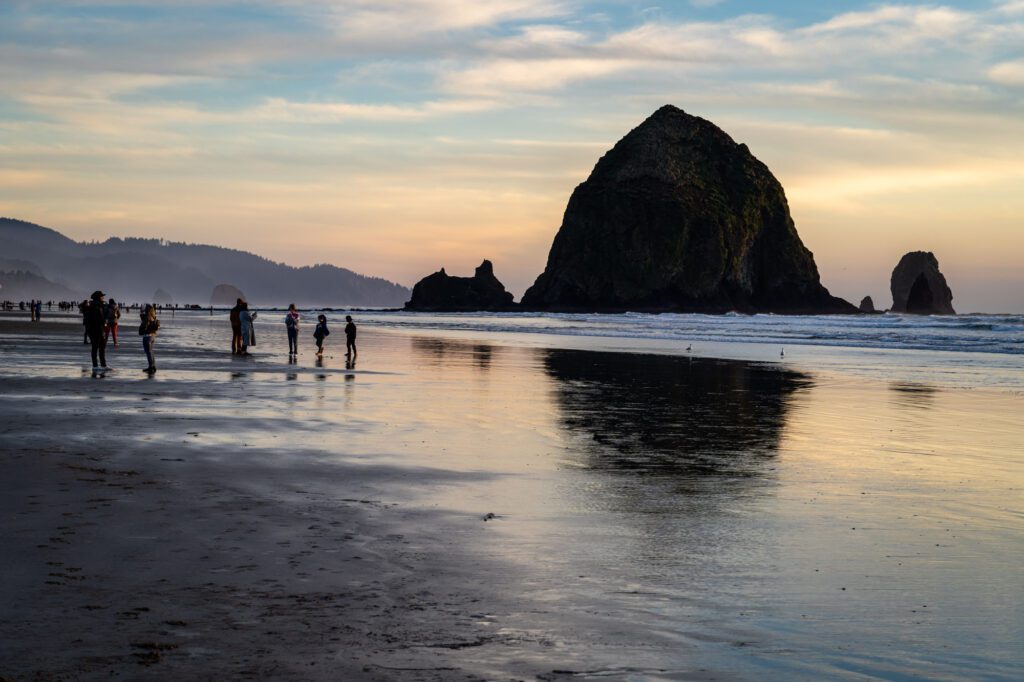
The Best Stops to Make on an Oregon Coast Road Trip
We’re going to organize this from north to south, because if you follow our advice and start and end in Portland, then that’s the easiest way to do it.
Doing it that way means you’ll have a short drive at the beginning to get to the starting point, but it also means that you’ll have a hefty drive back to Portland on your hands at the end if you do the entire thing.
We’d recommend heading out to the I-5 corridor from the southern coast and spending the night in Ashland or Eugene on the way back.
In the guide below, we’ll give you our favorite stops from north to south. Some of those stops – like Astoria and Newport – are worth at least one overnight depending on the amount of time you have. For those, you’ll find two subsections – what to do and where to stay.
Some stops are more of a stopover on the way to your next stop, and for those you’ll just find a section on things to do.
Anyway, here is our take on the best stops to make when you’re driving the Oregon Coast, from north to south.
Astoria
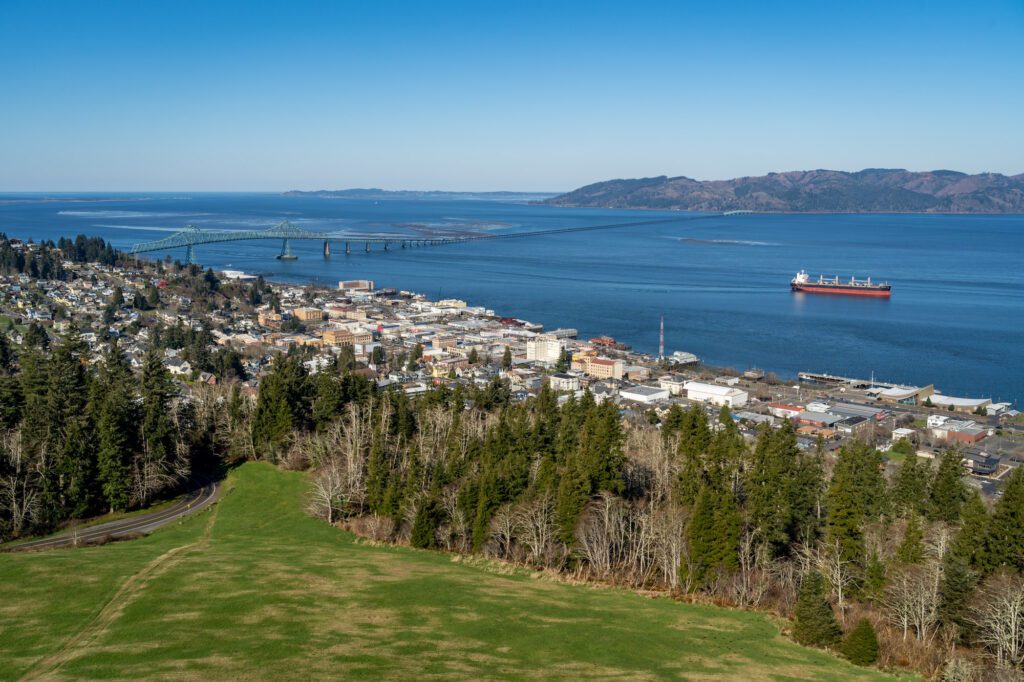
Astoria is a charming, somewhat sleepy little town at the northwestern corner of the state of Oregon. A surprising amount of history – both American and Oregonian – happened here, including the end of the Lewis and Clark expedition and the only attack on a mainland US military base since the war of 1812.
At one point, the Astor family (who named Astoria, clearly) had big, big plans for Astoria. Originally, because of its location at the mouth of the Columbia River where it meets the Pacific Ocean, it was thought that Astoria might become the New York City of the west. Which, obviously, didn’t quite come to be.
Today, Astoria is a great place to begin your journey down the Oregon Coast. There are a couple of wonderful parks, a stunning view from the Astoria Column, and some of the best breweries in Oregon.
Things to Do in Astoria
Here are some of our favorite things to do in Astoria, whether you’re planning on spending a couple of hours, or a couple of days in town.
The Astoria Column: The Astoria Column is perched up on the hill above Astoria, and has sweeping views of the town, the river, and the Astoria-Megler Bridge from the top. On the outside, there is a continuous mural depicting major events in the history of Oregon, which is pretty cool but hard to really take in without getting dizzy. Lucky for you, you can see it online here, complete with helpful historical context about what the images mean. Climbing the column is free, but it does cost $5 to park in the lot at the base of the column.
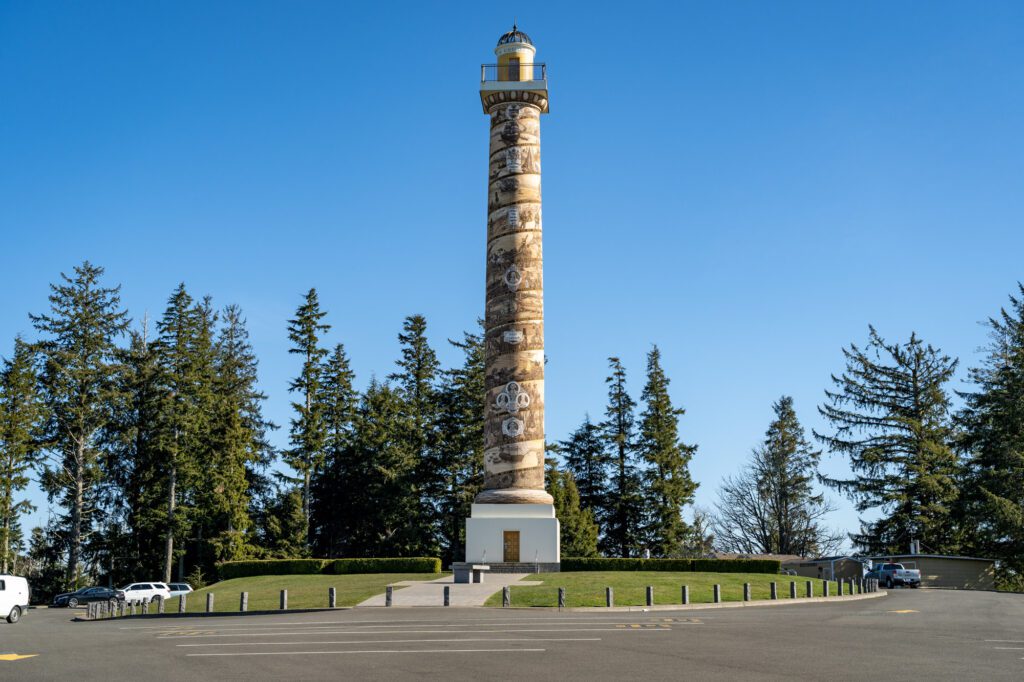
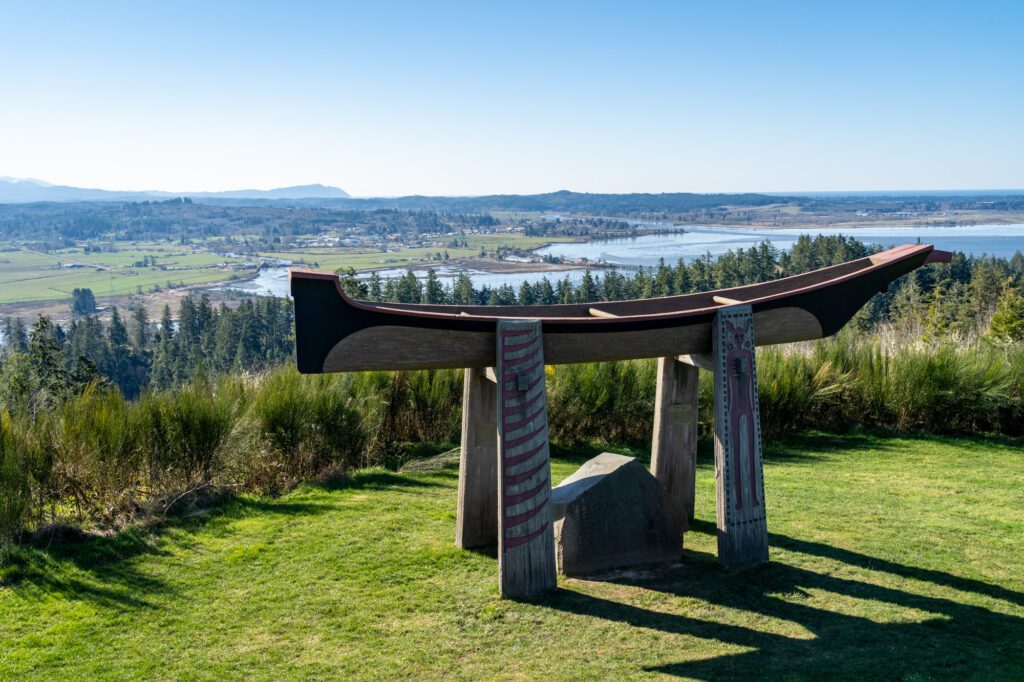
The Astoria Riverfront Walk: The riverfront in Astoria is full of history, and the official trail stretches 6.4 miles from the trailhead on the eastern end (here on Google Maps), heads under the Astoria-Megler Bridge, and ends at a point on the other side of town. Keep in mind that it’s nearly 13 miles to do it out-and-back. Our recommendation would be to do a portion of it – the portion from the Columbia River Maritime Museum out to the Astoria-Megler Bridge. It’s a nice walk past old cannery buildings, Buoy Beer, and out to a pretty stellar view of the bridge. Along the way, you’re likely to see (or at the very least, hear) sea lions!
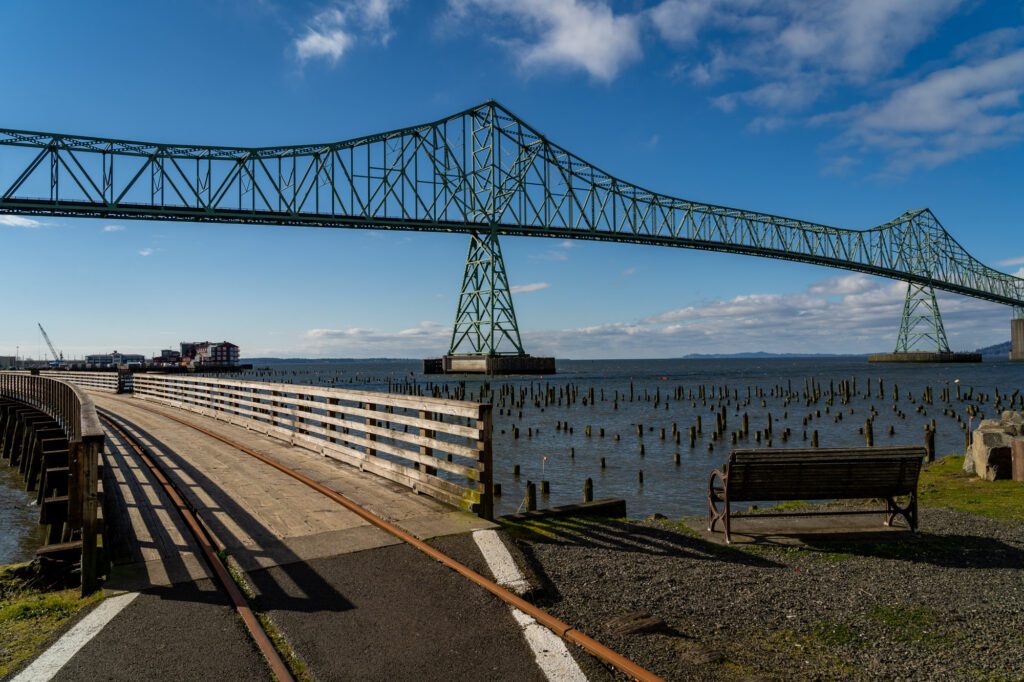
Breweries Galore: Most people talk about San Diego and Portland as the places with the most breweries per capita, but given Astoria’s small population and relatively large number of breweries, I feel like it has to be up there. Here are a few of them:
- Fort George, which has a huge taproom taking up most of an entire city block with multiple levels – including an open-air rooftop – is our top pick. They have a rotating selection of their beers on tap, along with a cider or two and (usually) gluten free beer in cans (which I very much appreciate, as someone with Celiac Disease who can’t have regular beer).
- Buoy Beer is the other popular spot right on the water, though they were closed when we were in town last and have a more underwhelming non-beer selection.
- The OG brewery in Astoria is Astoria Brewing Company, who started brewing beer in 1997 and has a nice industrial space on the riverfront walk.
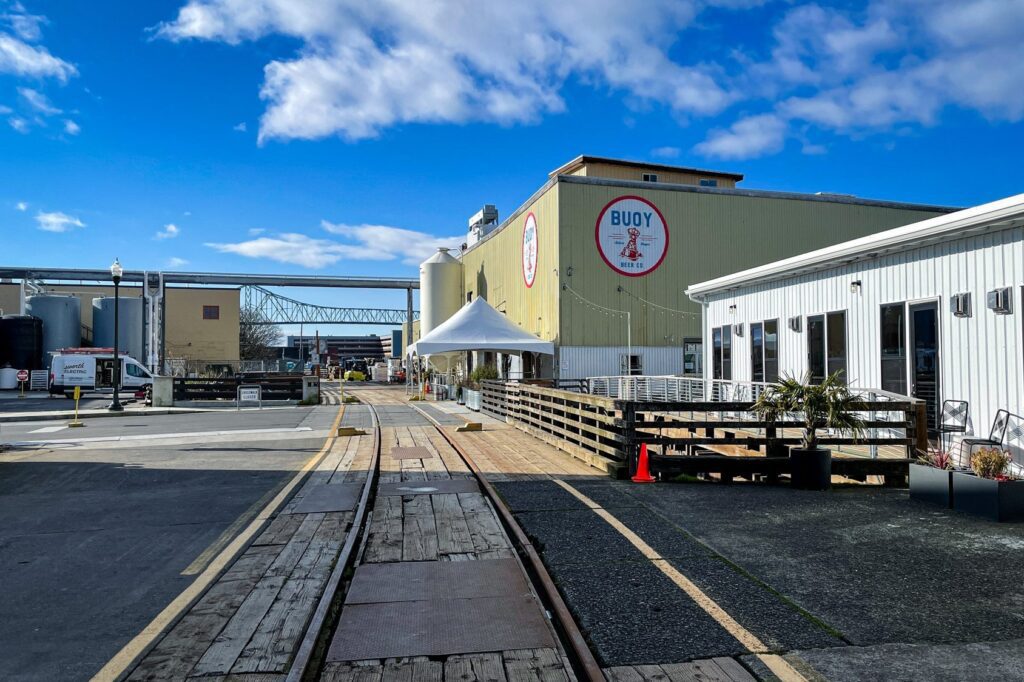
Lewis and Clark National Historical Park: Astoria was first put on a map (by the United States government, anyway) by the famous explorers Lewis and Clark, who were commissioned by Thomas Jefferson to find the Northwest Passage that would connect them to the Pacific Ocean for direct trading routes. At the time, it wasn’t called Astoria, but Fort Clatsop, and it was about five miles southwest of the city as we know it today where the expedition spent three (miserable, it sounds like) months experiencing a very wet Pacific Northwest winter in 1806 before triumphantly returning to St. Louis, their mission complete. We’d focus your time on two pieces of living history: Fort Clatsop and the Fort-to-Sea Trail. It’s $10, or free if you have an America the Beautiful Pass or an Oregon Pacific Coast Passport.
Fort Stevens State Park: Fort Stevens State Park occupies some prime real estate at the northwestern corner of Oregon, where the Columbia River meets the Pacific Ocean. The fort was constructed at the tail end of the Civil War to prevent enemy ships from gaining access to the Columbia River, and remained in operation until the 1940’s. There are two places in particular that we’d encourage you to visit as you do some exploring.
- The Peter Iredale Shipwreck: Probably the most famous piece of the park, the Peter Iredale ran ashore in 1906 as it was trying to navigate the famously treacherous waters of the mouth of the Columbia River and has been there since. It’s right on a long, sandy stretch of beach – which is a welcome change from the rocky beaches we have up in Washington – and it’s a lovely place to spend a sunset.
- The Northwest Corner of Oregon: Up to the north, you’ll find Clatsop Spit, which marks the northwestern-most point in the state of Oregon. There are a couple of parking areas up on the spit, and we thought parking lot C (here on Google Maps) was the best because of the view of the beach and coast to the south from the tower near the parking lot.
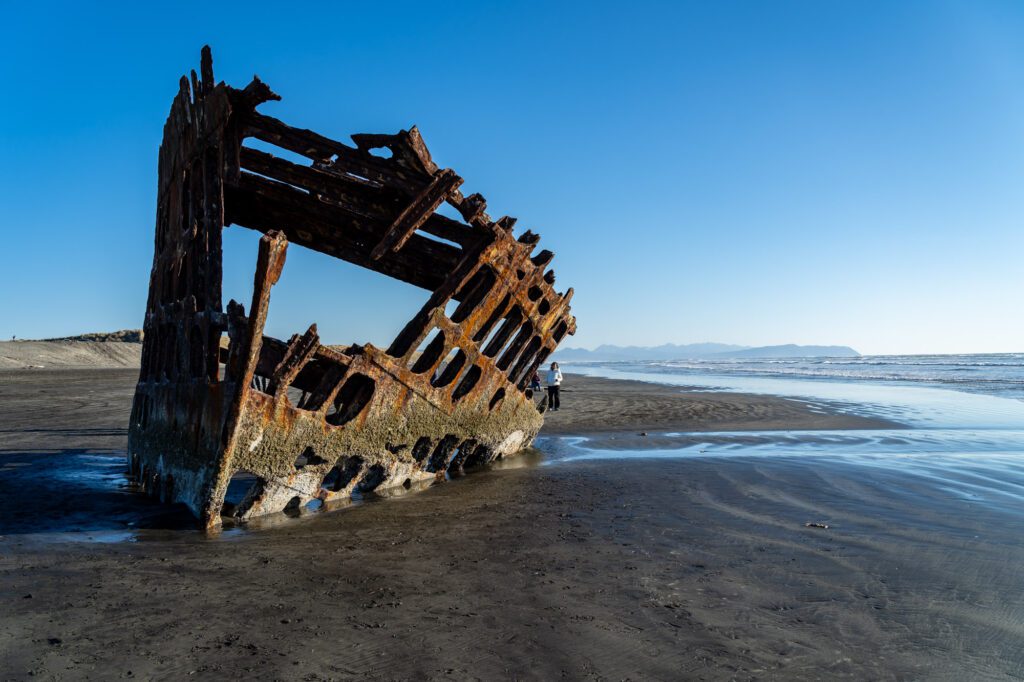
For more on what to do and see in Astoria, make sure to read our more detailed guide to the best things to do in Astoria!
Places to Stay in Astoria
Astoria has a surprising number of cool places to stay. We’re going to break them down into two categories. These categories aren’t really that mutually exclusive – you’ll be able to walk downtown from the waterfront hotels, and vice versa – but we think they’re a useful way to decide where to stay.

First are the waterfront hotels where you’ll be perched on the shore of the Columbia River as it flows west towards the Pacific Ocean. If that sounds like something you’re into, stay at the Bowline Hotel. We spent one afternoon strolling the path that the Astoria Riverfront Trolley (which was sadly closed when we were there) would take and were enamored with the Bowline when we walked by it.
It’s right on the water, next door to Buoy Beer Company, and about five minutes from most things in Astoria. Sure enough, I looked it up when we got back to our hotel (we’ll get to that) and it looks exactly like the kind of place we’d like.
It’s modern, stylish, the rooms are big and comfortable, and if you book a riverview room, you’ll have a nice patio looking out at the river where you can relax with a beer and watch the huge container ships float by.
The second category are the hotels in the center of town, where you’ll be walkable to the food, drinks, and shops of downtown Astoria.
We stayed at the Norblad Hotel, which is a hip hotel with super friendly staff in a perfect location and has rooms for a variety of budgets.

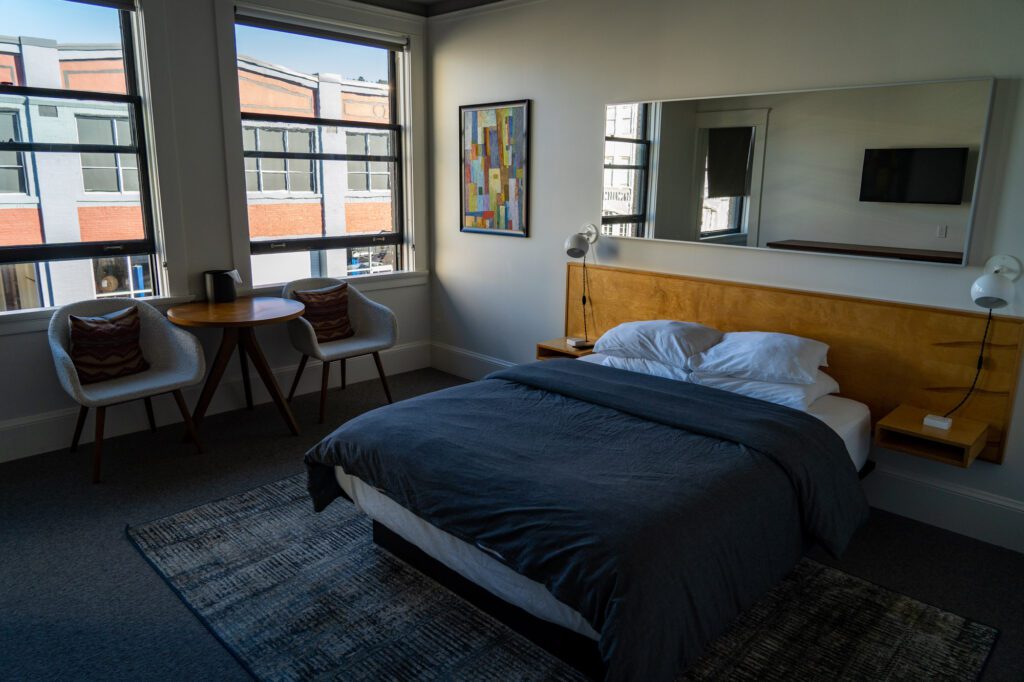
We knew we’d be doing some work from the hotel, so we chose a Queen Suite (which was perfect!), but they also have smaller rooms with shared bathrooms (single occupancy) that are perfect if you’re on a budget.
The last option is camping at Fort Stevens State Park. We have tried to get a reservation here and failed in the past. It’s competitive, so you’ll want to book early, particularly if you happen to be on the coast over a weekend.
Ecola State Park

We had never been to Ecola State Park until our fifth trip out to the coast – though we’d wanted to each of the four previous times.
The reason? Storm damage has had it closed since early 2020!
But if that road out to the park is open for your trip, you definitely should for the incredible views out over Cannon Beach, with its crashing waves and towering sea stacks.
The park covers the area around Tillamook Head, which the Lewis and Clark expedition famously climbed, later writing about the panoramic coastal views (and the really, really hard climb).
Here are Clark’s words about the views, in case you’re not sure if you should make the stop or not: “… the grandest and most pleasing prospects which my eyes ever surveyed.”
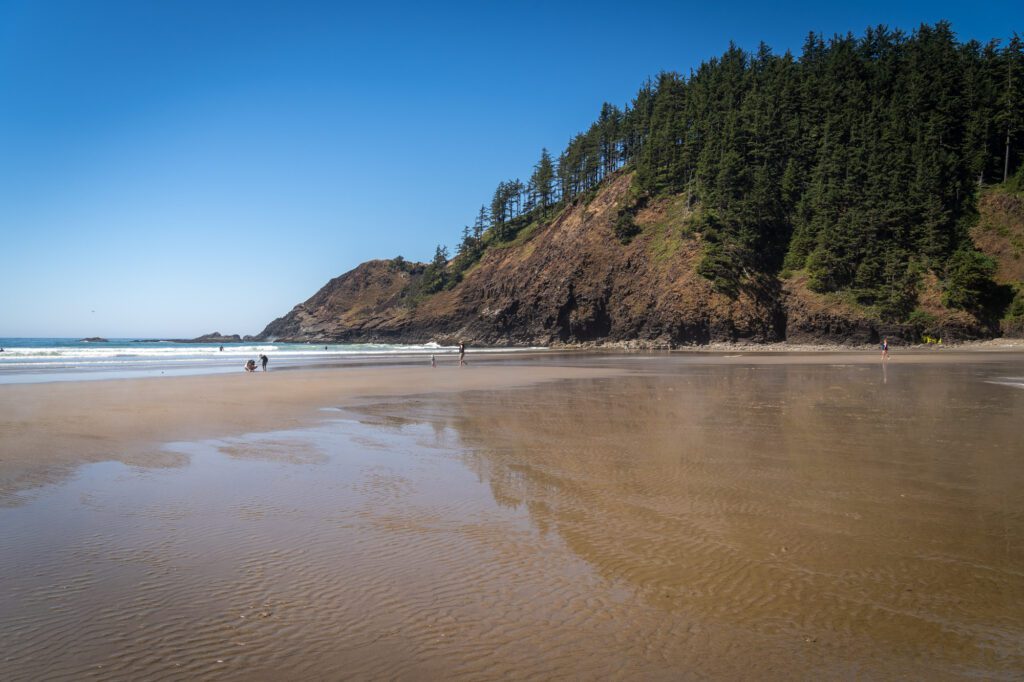
We love Indian Beach, and have spent a sunny day there escaping the 100+ heat in Portland with friends. Highly recommended if it’s brutally hot in the city – it’s a solid 20+ degrees cooler near the ocean!
There are a couple of notable hikes to tackle while you’re here.
Clatsop Loop and Indian Beach: First is the Clatsop Loop Trail, which leaves from Indian Beach (another spot worth exploring) and heads north along the coast towards Tillamook Head with some nice views along the way.

Crescent Beach: Accessible via a mile-long trail (one way) from the main parking lot (here on Google Maps), this hike takes you down to a nice, secluded beach on the south end of the park.
You can check the current park conditions here.
Cannon Beach
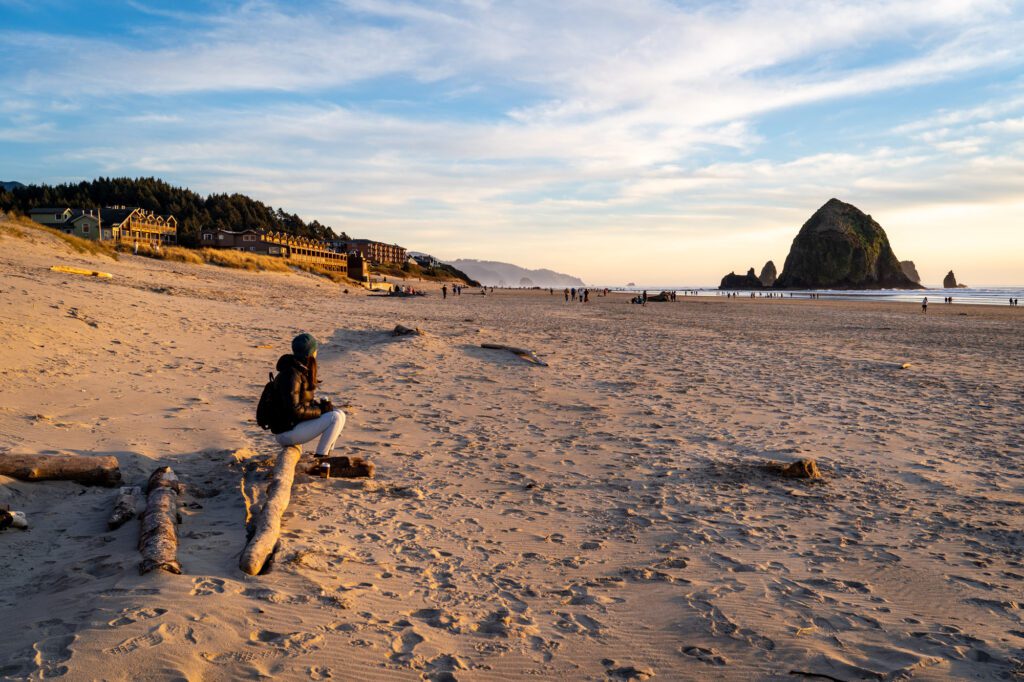
Cannon Beach is perhaps the most famous of the northern Oregon Coast towns, primarily for two reasons. Its proximity to Portland is the first. At just over 90 minutes away, it’s a perfect day trip from Portland if you’re looking for some beach action.
Second is Haystack Rock, which is featured prominently in every Pacific Northwest photographer’s Instagram and portfolio.
The town of Cannon Beach is charming and a little bit cheesy, but is an excellent stop on your road trip as a home base for exploring the state parks immediately north and south of town.
If you’re familiar with the Oregon Coast at all, you’ll notice that we completely skipped Seaside. After poking around Seaside for an afternoon, we decided that basically anything you can find in Seaside you can find in other places on this itinerary. And by and large, whatever “things” we’re talking about are generally done better elsewhere on the coast.
For example, the aquarium. The Seaside Aquarium is tiny. If you’re in the mood for an aquarium and you’re making it down to Newport, hold out for the Oregon Coast Aquarium in Newport, which rivals the Monterey Bay Aquarium in California for the best we’ve ever been to.
We do like the idea of the Funland Arcade and the bumper cars across the street, though. But overall, we think your precious time is better spent elsewhere. Some people probably love Seaside (especially if you have kids), but it wasn’t our thing.
Anyway, back to Cannon Beach, which is a similar idea to Seaside in that it’s a coastal resort town whose population balloons in the summer as people escape to the coast, but is much, much more inviting and charming.
Things to Do in Cannon Beach
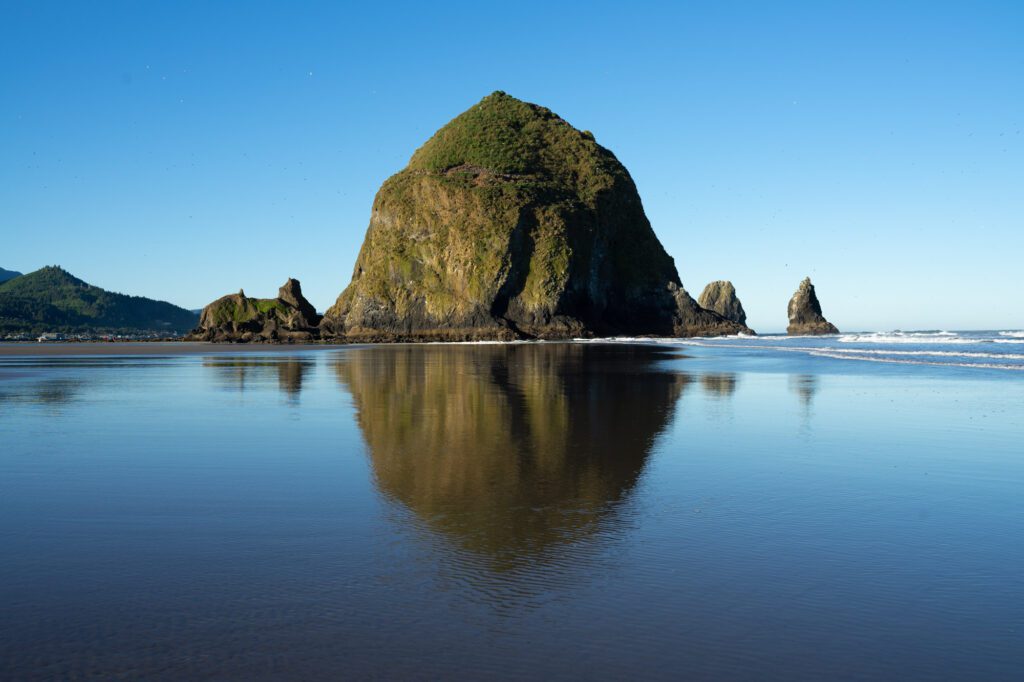
Here’s what we’d do in and around Cannon Beach.
Public Coast Brewing: Local beer, and gluten free fish and chips (though you’d never know it!) at the northern end of town near the entrance for Ecola State Park. A perfect post-hike refuel stop!
Haystack Rock: Perhaps the most famous scenery on the entire Oregon Coast, Haystack Rock is a giant sea stack just off of the coast on Cannon Beach that towers over the surrounding area. It’s an excellent sunset location! There’s also a puffin colony that calls the rock home, which is fun to learn about from the rangers on the beach.
Good Coffee: If you’re in the mood for some good coffee, head to either Insomnia Coffee Co. or Sea Level Bakery + Coffee. Insomnia is right in town, Sea Level is about ten minutes south on the way to Oswald West State Park.
Hug Point: First of all, this is only a low tide place to visit, because when the tide is out, this is a huge stretch of beach with all sorts of fun tide pools that is really only accessible at low tide. Check tides here. The parking lot is small, which means you’ll want to either get here early in the morning (again, depending on tides!) or be prepared to wait for a parking spot if you’re here on the weekend.


Places to Stay in Cannon Beach
We stayed at the Inn at Haystack Rock, and realized that we had unintentionally booked a stay in the perfect location. It’s walkable to the main downtown area of Cannon Beach, and it’s a block away from the beach itself, and a 10-15 minute walk away from Haystack Rock.
The rooms could use a few updates, but they have rooms with kitchens, which is something we wanted, and our particular cottage was nice and cozy, with an electric fireplace in the bedroom.
If you want to actually stay on the beach, which is something we wanted but couldn’t find a place with kitchen facilities (Matt has Celiac Disease, which means he has to eat 100% gluten free and we generally cook a lot on the road).
If that hadn’t been a consideration, we’d have stayed at either the Schooner’s Cove Inn, which is right in the middle of the action on the downtown strip, or Surfsand Resort, which is right on the beach and has rooms with views of Haystack Rock.
Oswald West State Park

Short Sand Beach: Heaven for surfers, this beach is super popular with the surfing community in Oregon, and even on a rainy, stormy day you’re bound to find at least a couple of dedicated surfers sitting in the water.
The Cape Falcon Trail: The muddiest hike we’ve ever done, this hike takes you out around the cape on the right side of Short Sand Beach to a great view. It’s relatively easy, but I’m not joking when I say that it’s one of the muddiest hikes we’ve ever had the privilege of doing. Be prepared. More trail information here.
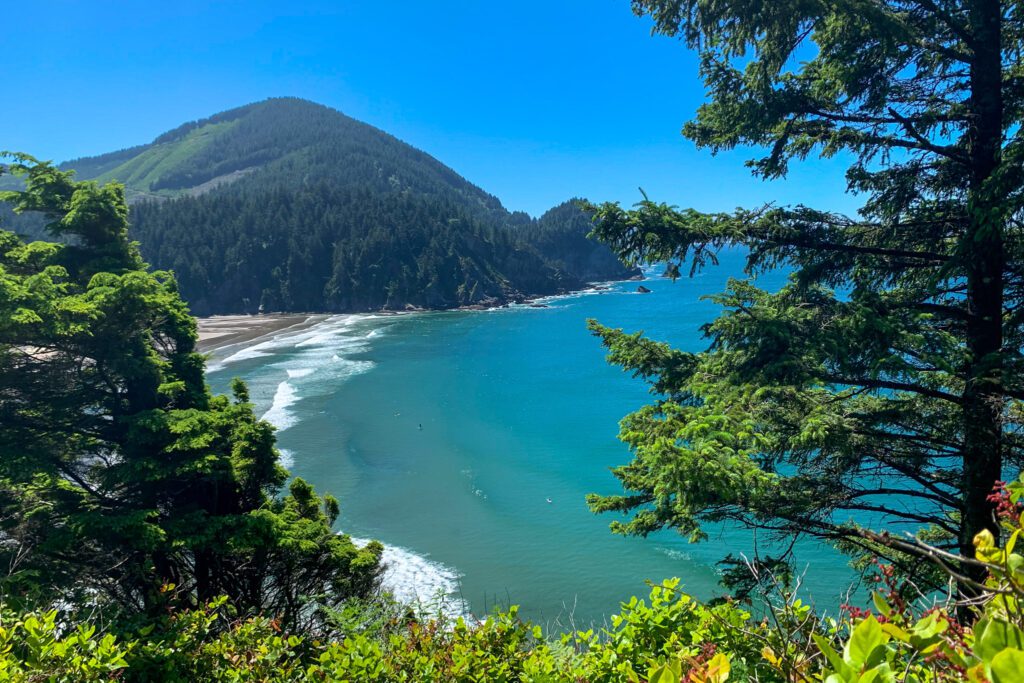
The Neahkahnie Mountain Trail: This is probably our favorite of the hikes in Oswald West State Park. And it’s really just because of the vista at the top, which includes a view of Manzanita Beach stretching endlessly south. There are multiple ways to do this hike, and the most popular version is to start from the northern trailhead, which is right off of 101. This is also the longer, harder version of the hike. The alternate option is to go from the south trailhead, which is a half mile off of 101 up a narrow forest road, which cuts the distance to 2.6 miles and 850 feet of elevation gain.
Tillamook
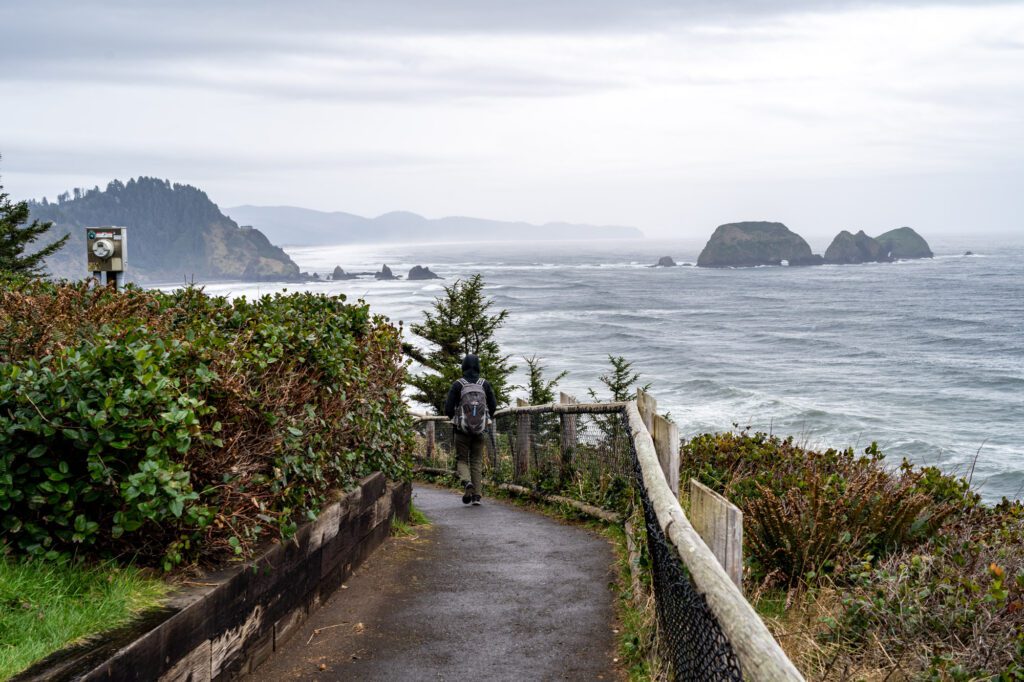
The town of Tillamook itself is fine, but the real beauty of Tillamook is the wealth of incredible nature that is accessible within 30 minutes or so. If you’re short on time, driving the Three Capes Scenic Route is a must-do (and you could do it as a one-way drive on your way south).
Oh, and the cheese. There’s not one but TWO places to get amazing cheese in Tillamook (more on that in a second).
Things to Do in Tillamook
Here are a few things to do in Tillamook that should keep you busy for a day or two.
Devour Delicious Cheese! There are two great places to get farm-fresh cheese in Tillamook. The most famous (and our personal preference) is Tillamook. Whether or not you’re familiar with the Pacific Northwest, you’ve likely had Tillamook cheese before. But I’m not sure how many people have had the pleasure of tasting their ice cream, which is some of the creamiest ice cream we’ve ever had. It’s not gluten free, but Alysha loves it (their chocolate peanut butter ice cream is legendary). At their factory, they have an ice cream bar with all sorts of different unique flavors, along with some unique cheeses that you can’t really find elsewhere. Plus, cheese curds! Blue Heron is just down the road, and specializes in French cheeses (think Brie) – we loved their herb brie.
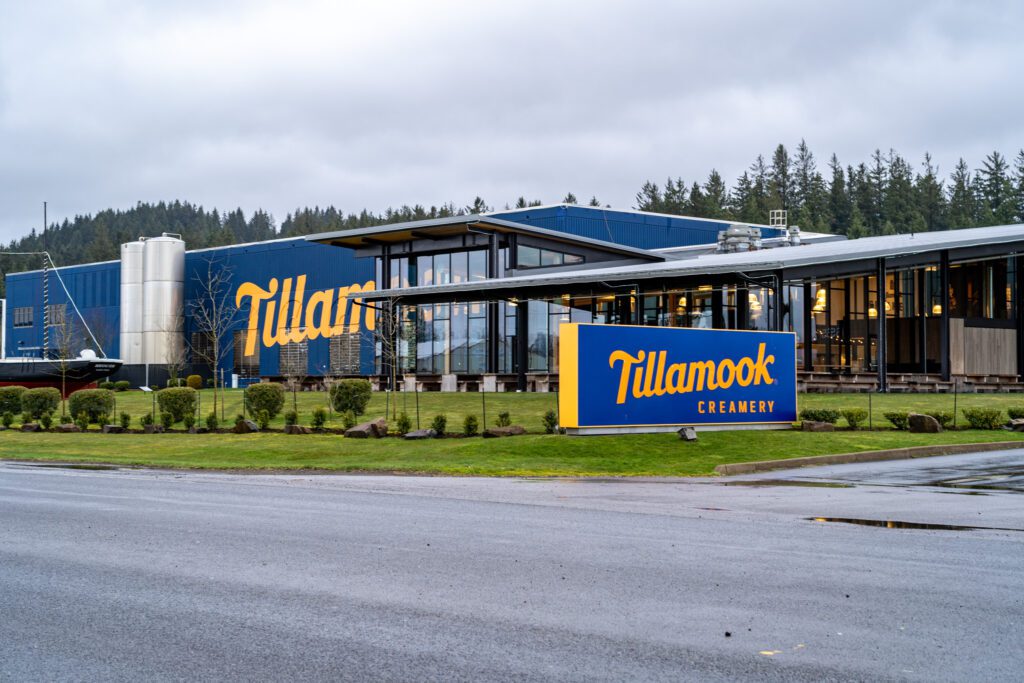
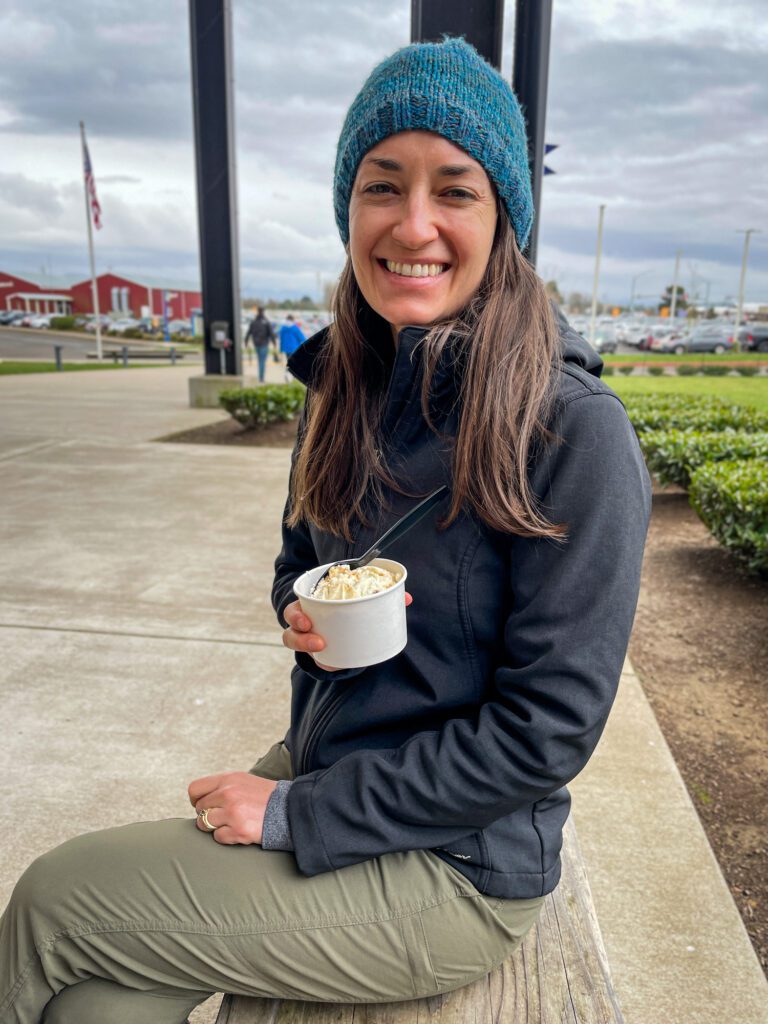

Drive the Three Capes Scenic Route: This drive takes in, you guessed it, three different capes. You’ll start at Cape Meares, make your way south to Cape Lookout, and then head down to Cape Kiwanda. Here are more details on those stops.
- Cape Meares: You’re mostly here for the lighthouse, which is hard to photograph, but the walk up to the so-called “Octopus Tree” is also worth the quick detour. Throughout the park you have really nice rugged coastal views.
- Cape Lookout: Probably our favorite of the three capes, there are two main things to check out here. First is the beach, which is accessed by parking at the lot here. Second is the Cape Lookout Trail, which takes you out to the end of the Cape (through a nice temperate rainforest, I might add) where amazing coastal views are waiting for you.
- Cape Kiwanda: Furthest south, Cape Kiwanda is another great surfing spot, and you’ll routinely find many, many surfers out in the water. You can also drive out onto the beach here, which is fun (though we didn’t dare in our minivan). The highlight here is the hike up on the sandy headland on the right (that’s north) side of the beach. There are great views of Cape Kiwanda from the top, but there are also some nice views back to the north on the other side. It’s also worth stopping for food or coffee at Stimulus Coffee & Bakery, which is across the street from the main parking lot. The coffee is excellent, and though I can’t speak to the baked goods (I have Celiac Disease), the line tells me they’re probably pretty good.


Places to Stay near Tillamook
We stayed at Sheltered Nook, which is a little collection of tiny houses just north of town. We really enjoyed it, and they’re small, but surprisingly comfortable!

There’s an electric fireplace, a nice kitchen with everything you need to cook a meal (or just seven bags of cheese curds, your choice, I guess), and it’s dark and quiet so you’ll get a great night of sleep. Plus a nice common area in between the houses with fire pits, picnic tables, and barbecues.
We have also camped at Cape Lookout State Park, which is a super nice campground right on the beach at Cape Lookout. If you’re up for camping, you can’t go wrong there.
Lincoln City
Lincoln City is on this list because it’s home to not one, but TWO of our favorite hikes on the Oregon Coast.
It’s a sleepy resort town about 45 minutes south of Tillamook, and other than these two hikes there’s not really that much to do or see nearby. There’s a wide, sandy beach, which is nice, but to be honest, there’s a lot of those on the Oregon Coast.
For us, it’s all about the hikes. And it would make a fantastic stop to break up the drive between Tillamook and Newport, your next main stop.
Option 1: Cascade Head: The first is Cascade Head (from the lower trailhead), which takes you up a steep set of stairs and through a dense forest before emerging onto a headland with spectacular coastal views. Continue climbing past a lower viewpoint up the ridge to the upper viewpoint for even better views, which you might not believe is even possible. We did this hike on a very stormy, windy day in February, and we still enjoyed it! There are a couple of ways to do this hike, and the easiest and most direct is to drive most of the way up to the upper trailhead, which results in a shorter, easier hike.
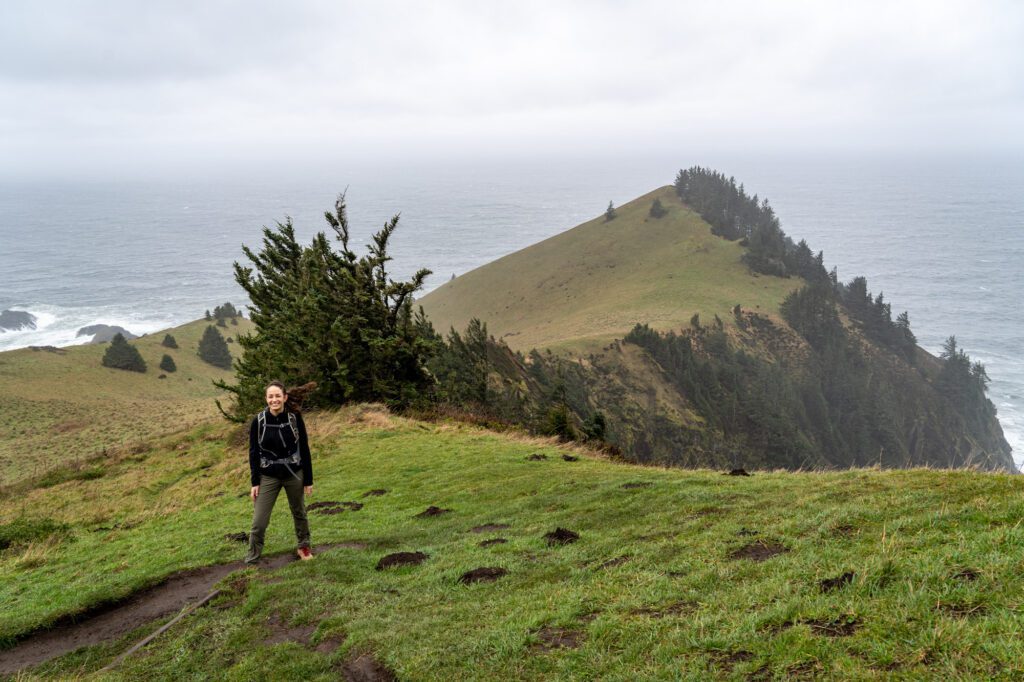
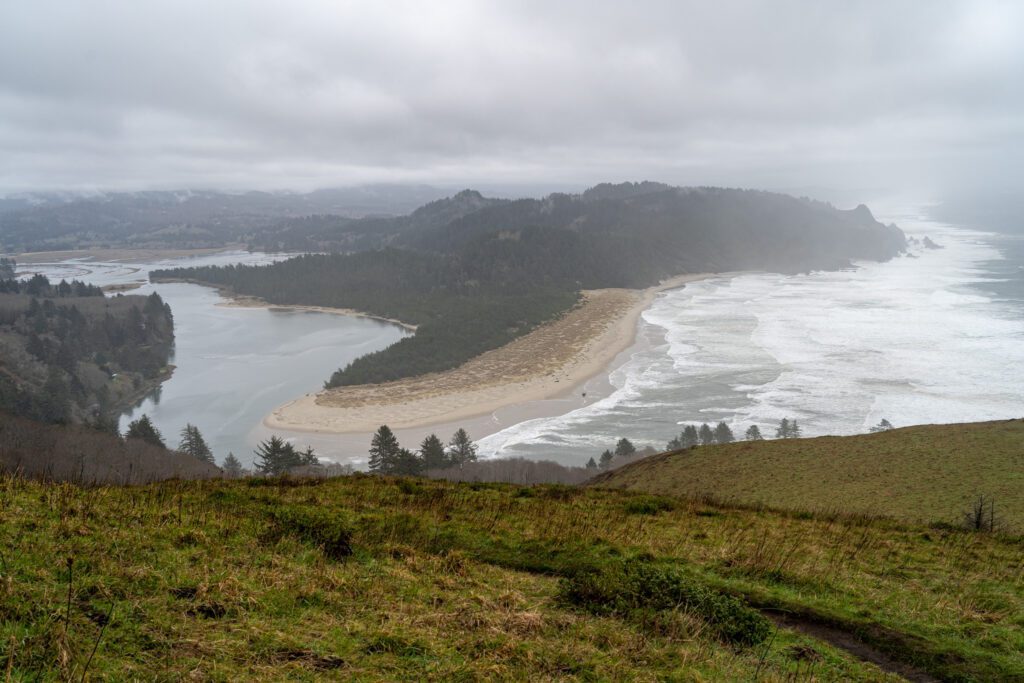
Option 2: God’s Thumb: The second hike here is God’s Thumb, which takes you out to a cool, for lack of a better word, natural terrace with great ocean views. The last part of this trail gets a little sketchy, as you’re climbing on a narrow trail with steep drop offs to reach God’s Thumb. Only do what you’re comfortable with, and be careful when it has been raining and this part of the trail is muddy. From the top of the Thumb, you have pretty spectacular coastal views awaiting you. This would be an excellent sunset hike, where you’ll be awash in a soft golden glow as the sun sets over the Pacific to the west.
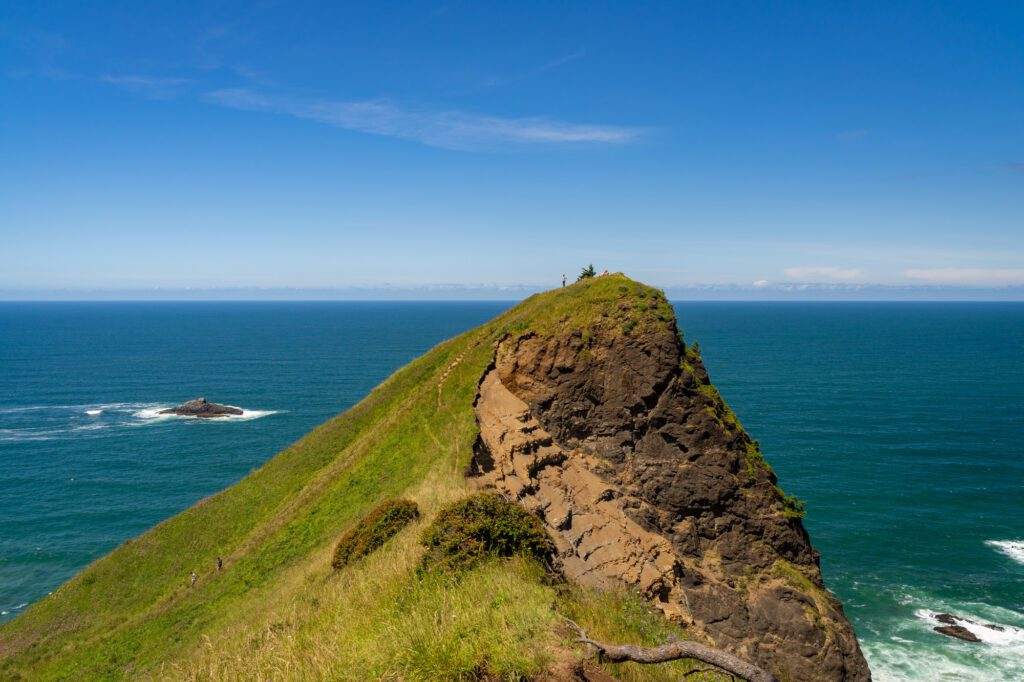
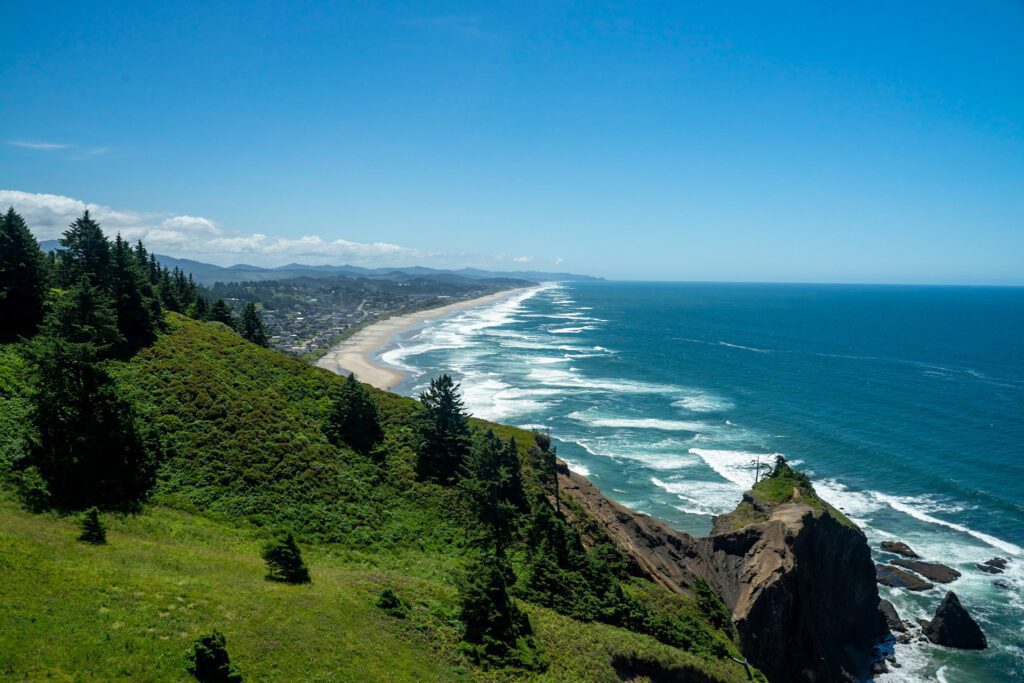
Newport
To us, Newport very much feels like a midpoint on the Oregon Coast. Both in terms of geography – it’s right around the middle of the trip down the coast – but also in terms of vibes.
It’s the last bigger city (town?) on the coast if you’re heading south, and there’s a surprising amount of bars, restaurants, shops, and other amenities that you might find in a city.
But you get outside of town to the south and it very quickly becomes the rugged, wild southern Oregon coast as you make your way towards Cape Perpetua.
Newport is worth an overnight stop, since you’ll have a drive of a couple of hours coming from Tillamook, and another couple of hours before you reach your next stop after you pass through Newport. Plus, it’s a nice place to hang out, and it’s worth spending an afternoon and evening exploring the Bayfront, where you’ll find a fun stretch of bars, breweries, and restaurants to peruse.
Things to Do in Newport
Newport is one of the biggest towns / cities on the Oregon Coast, so it has a lot going on.
Yaquina Head Lighthouse: A must-stop just north of Newport, this is a beautiful lighthouse perched on a head at the northern mouth of Yaquina Bay. It’s a short walk out to the lighthouse from the parking area, but you should also try to walk down to the beach on the north side (both Cobble Beach and Quarry Cove). There’s an extensive visitor center here too.
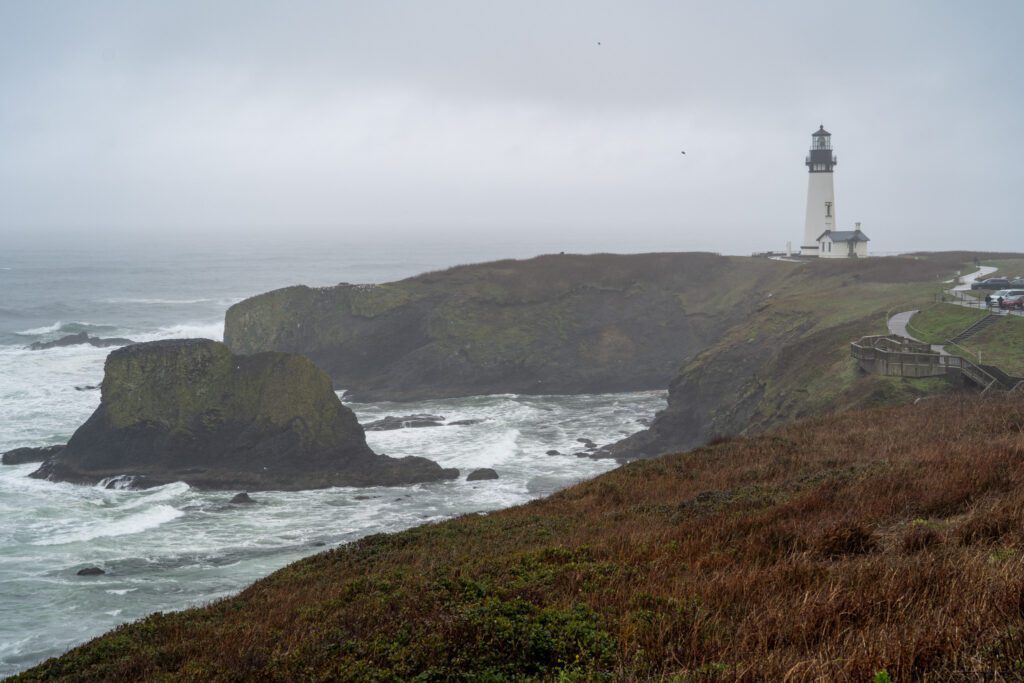
Nye Beach: The best beach in Newport! Splurge on a dinner at Zach’s Bistro if you have the chance (they have plenty of gluten free options!). Agate Beach – which Matt learned is not pronounced “Ah-gah-tay” but “Agitt” – is another good one, just north of town.
The Oregon Coast Aquarium: This is probably the best aquarium on the west coast aside from the Monterey Bay Aquarium. We had every single intention of going here. Until, that is, we showed up on a weekend afternoon and realized that it was the busiest time possible, with hordes of screaming kids making their way towards the entrance. So we decided to skip it. But that doesn’t mean you should! It’s a little expensive at $25 per adult, but if you’re interested in the marine life on the coast, it’s worth it. If you want to see what you’re getting yourself into, they have a bunch of live cams where you can see the enclosures for the otters, sea lions, etc. More information here.

Food and Drinks in Newport: A couple of notable spots are Mo’s Seafood and Chowder (for the, well, seafood and chowder), Clearwater (for a nice dinner with views of the Yaquina Bay Bridge), and if you’re looking for a drink, Newport Brewing Co.
Places to Stay in Newport
There is exactly one place we wanted to stay in Newport, and it didn’t quite work out on our latest trip because it was a weekend and we were booking relatively late. Bummer. So we actually continued on south all the way to Coos Bay for the night.
That place is the Inn at Nye Beach.
It’s right on the beach, the rooms are gigantic – for hotel room standards – and you can choose between a city and ocean view. The gas fireplaces are a nice touch for winter and spring trips.
Cape Perpetua & Heceta Head Lighthouse
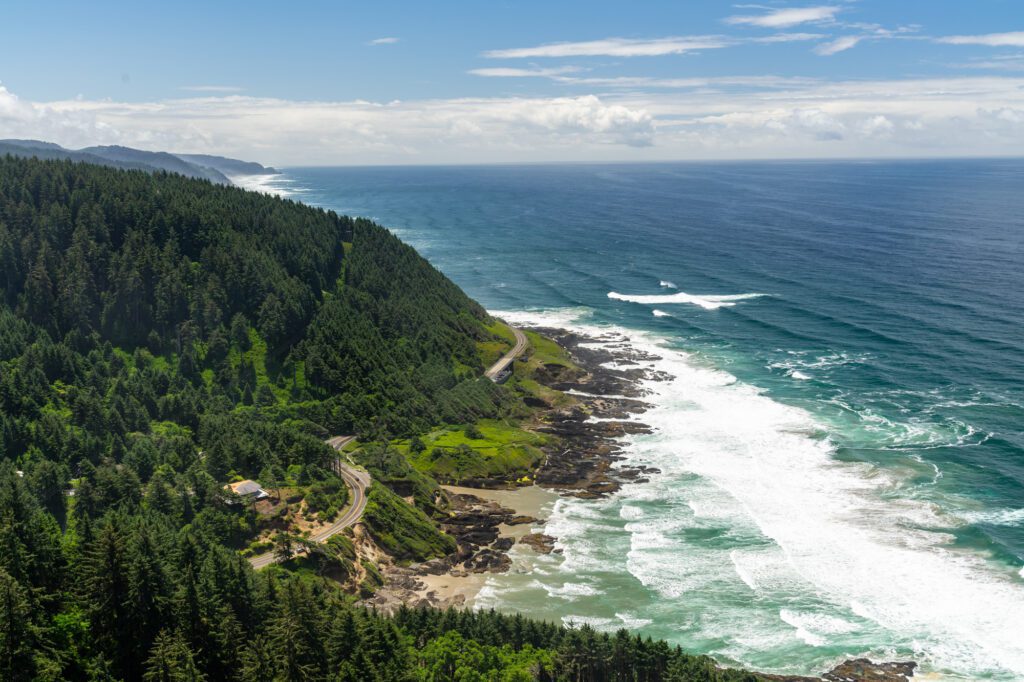
The stretch from Cape Perpetua to Heceta Head Lighthouse is probably our favorite part of the Oregon Coast, and reminds us of the drive from San Francisco to Los Angeles through Big Sur.
It’s a big bluff that rises almost 1,000 feet out of the ocean below, which means from the scenic viewpoint at the top, you have an incredible view of the never ending coast to the south.
While technically Cape Perpetua Scenic Area refers to a relatively small piece of the coast south of Yachats, we’re going to include the entire stretch of coast between Cape Perpetua and Heceta Head Lighthouse in this section.
It’s worth stopping by the Cape Perpetua Visitor Center (here on Google Maps) to get your bearings, check out some maps, and talk to a ranger to see what’s happening at the moment.
Here are some must-stop places along this stretch of the Oregon Coast, from north to south.
Devil’s Churn: A short stop where you’ll hike down to an overlook with a view of an inlet that is partially covered at the end. Which means at high tide, if you’re lucky, the waves coming in will meet the waves going out and create an explosion of water.
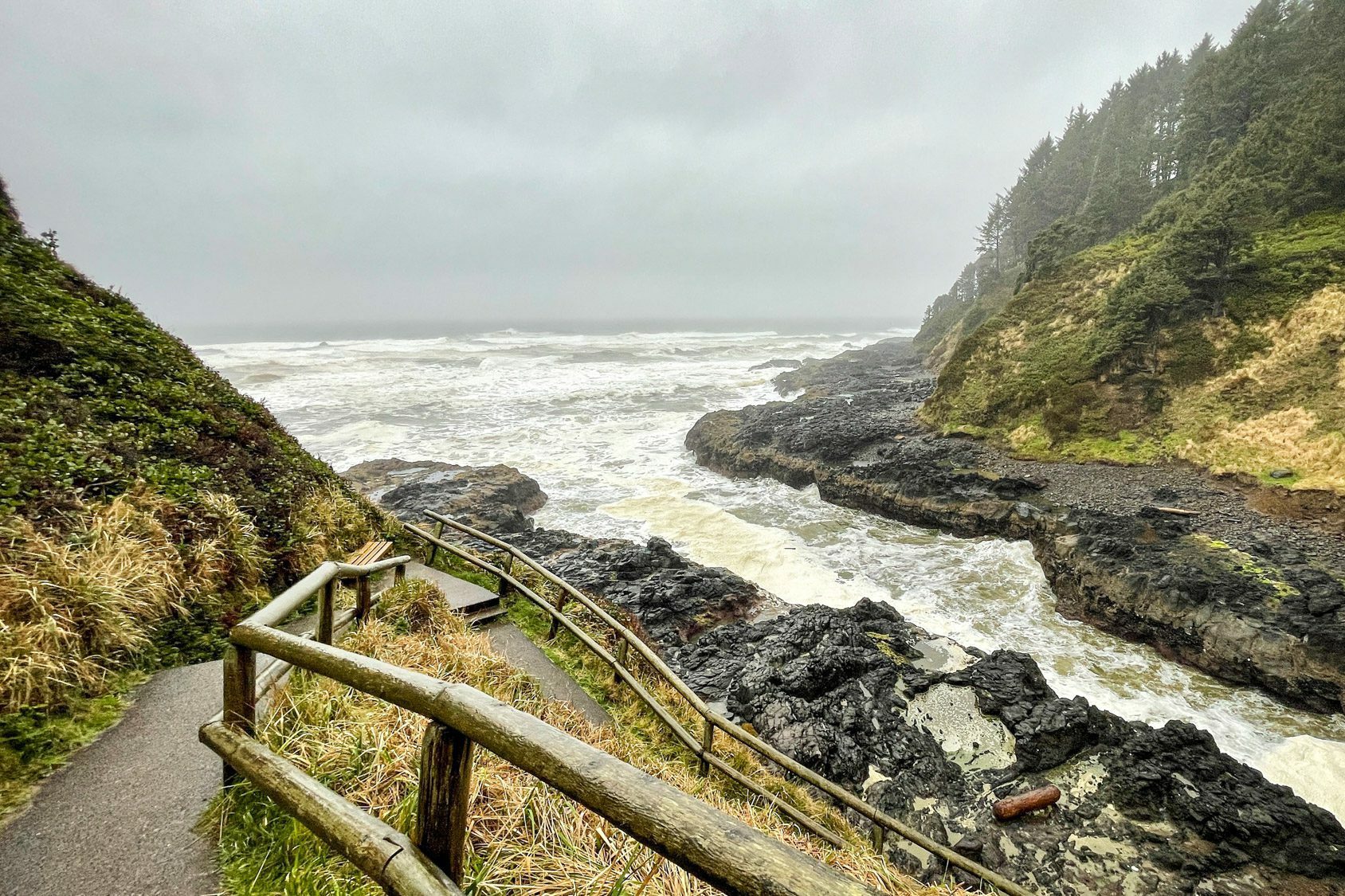
Cape Perpetua Lookout: This lookout (here on Google Maps, pictured above) is the best view on the Oregon Coast. In our opinion, anyway. For some reason, the first time we drove the Oregon Coast, we thought you had to hike here to get this view via the Saint Perpetua Trail. Imagine our disappointment when we realized upon arrival at the top that you could just drive here (the trail is still a good workout, though we’d probably just drive next time). Anyway, from the top, you get a nice view of the rolling waves and coastline below, and we definitely think it’s worth the stop.
Thor’s Well: This is a cool spot just south of the access road up to the viewpoint. You’ll take a short walk out to the shore, where you’ll find Thor’s Well. What, exactly, is Thor’s Well? The current thinking is that it’s a collapsed sea cave, but nobody really knows. What we do know is that it’s worth the short detour to see the “well” fill up as the waves come crashing over the shore, and then slowly drain through a hole in the sea-facing wall. You should know that there’s really nothing to see here at low tide – we’re speaking from experience – the best time to visit is right before or after high tide, when the water comes up over the edge of the well and drains when the tide recedes. Check tides here. For photography purposes, you’ll need very specific conditions to get the perfect shot – I liked this guide, though sadly we didn’t get a good shot of our own because of the tides.
Heceta Head Lighthouse: We’ve now officially left Cape Perpetua, and are now about 15 minutes south. This is one of the best lighthouses on the Oregon Coast (it’s about even with Yaquina Head in Newport, we think), sitting hundreds of feet above the ocean looking out from its perch on Heceta Head. It was built in 1894, and still operates today (though it’s automated). You’ll need to either pay $5 or have an Oregon State Parks Pass to park at the lot, then it’s a nice walk up to the lighthouse’s perch. Today, there’s even a bed and breakfast at the historic keeper’s quarters! You can also hike from the lighthouse to Hobbit Beach – more information here.
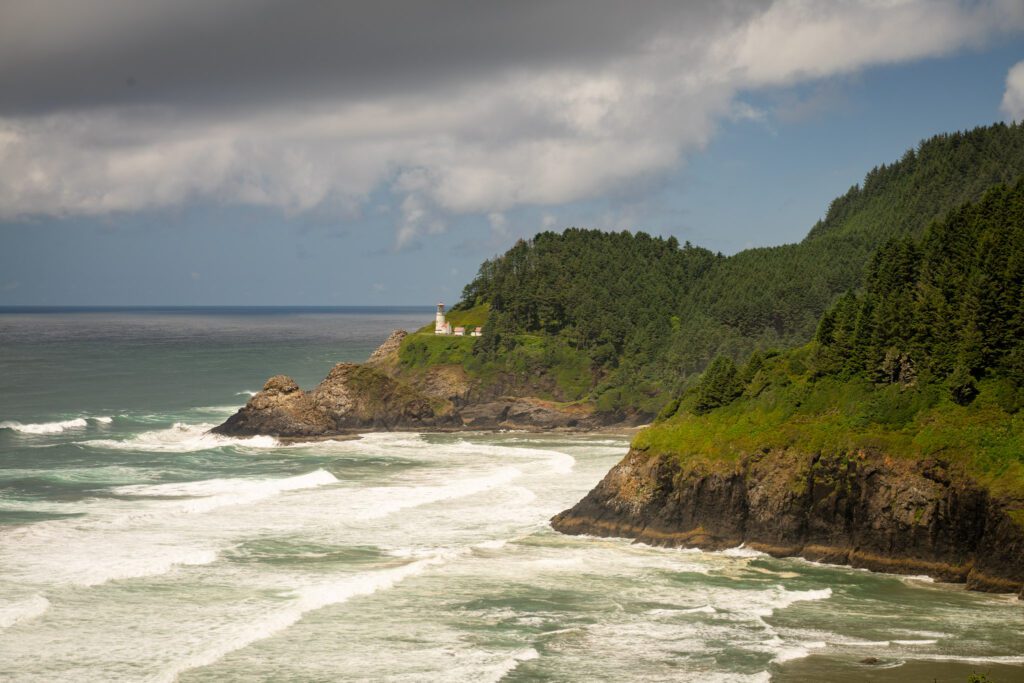
Sea Lion Caves: Look, we drove past this place on our first trip, saw a line out the door of a tiny little touristy-looking hut, and said “look at those suckers!” Then we learned what it actually was later on, and were at least a little bit disappointed that we didn’t stop in. If you want to see sea lions, this is the place to do it. That hut sits over an elevator that takes you down hundreds of feet to the water level, where there’s a sea cave – America’s largest, in fact – filled to the brim with barking sea lions. Skeptical? Here’s the webcam where you can see for yourself. They’re open 9:00 am – 4:00 pm 363 days a year, and it costs $16 for adults, $10 for kids (under 4 are free!), making it a little bit pricey.
The Oregon Dunes

Continuing south from the sea lion caves, you’ll pass through the small town of Florence before hitting the most unique stretch of the Oregon Coast, the Oregon Dunes. Stop by River Roasters for some good coffee in town, and then head out to the dunes.
The Oregon Dunes National Recreation Area is a huge stretch of coast covering 31,500 acres along the coast between Florence and North Bend.
Driving along the road is a weird experience, because for large stretches you actually can’t see the dunes. You might start to notice the sand along the sides of the road, but you’ll essentially have forest on one side, and a string of lakes on the other, with exactly zero dunes in sight.
What you can’t see is on the other side of that forest, there’s a huge swath of land that is basically just a bunch of rolling hills of sand that take you all the way to the ocean.
You should know that OHVs are legal on the dunes, which means you’re very likely to hear the humming of engines revving as you try to enjoy your peace and solitude.
There is one place we think you shouldn’t miss – though there are obviously tons and tons of things to do and see here. We’re not into OHVs, so it’s not really our thing. But if you are, then you can rent one or join a guided tour at Spinreel in North Bend.
The John Dellenback Dunes Trail (5.5 miles RT)
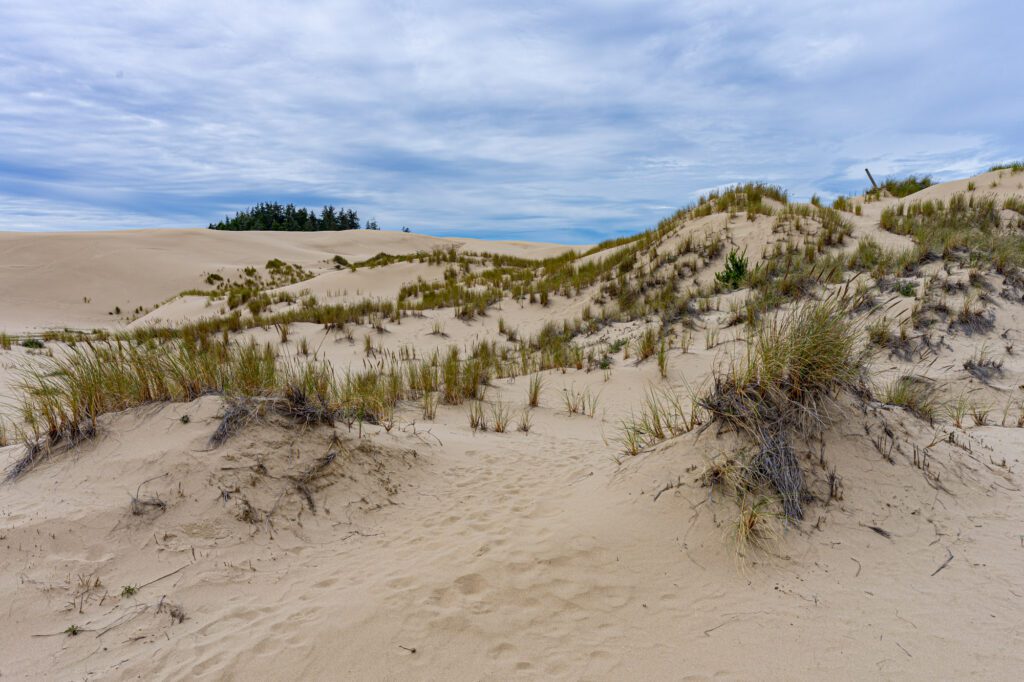
This is the best hike to experience the dunes, we think. You’ll start in the forest, though you’re walking on sand as you make your way to the edge of the trees, where you’ll come face-to-face with the sprawling dunes stretching out for miles.
The coolest part is the islands of trees that somehow exist smack dab in the middle of the dunes.

You’ll snake your way across the dunes – remember, hiking on sand is HARD – before briefly re-entering a different forest and emerging out onto a neverending wide sandy beach, where you’re likely to be one of just a few people out there.
Bring plenty of water and snacks – this hike is probably going to take you longer than you think.
More trail information, including recent trail reports, here.
The Tahkenitch Dunes Trail is a good alternative, but we prefer the John Dellenback version.
Coos Bay & Bandon

The towns of Coos Bay and Bandon, which are about 30 minutes apart, form a nice stretch of coast ranging from rocky and rugged places like Cape Arago, to wide sandy beaches like the ones near Bandon.
The town of Coos Bay isn’t really worthy of too much of your time – but the stretch of state parks to the west between Sunset Bay State Park and Cape Arago is great – and Bandon is definitely worth a stop. B
andon is a sleepy little beach town, with a brewery and cidery, and two pretty spectacular beaches that have to be among the best on the entire coast.
Things to Do in Coos Bay and Bandon
Here are a few things to add to your itinerary between Coos Bay and Bandon.
Sunset Bay State Park: The beach is the highlight here, and it’s a nice protected cove safe from the crashing waves that exist just outside the walls of the cove. This is also the starting point of an 8.5 mile hike along the coast (part of the Oregon Coast Trail) connecting Sunset Bay with Shore Acres and Cape Arago – more information here.
Shore Acres State Park: The highlight here is the garden, which includes an impressive rose garden.

Cape Arago State Park: Another cape? How many capes are there on the Oregon Coast? Apparently there are 11 named capes, and probably countless unnamed ones. Anyway, Cape Arago State Park is the end of the road out here west of Coos Bay, and is a place to see sea lions and other sea life from an overlook that sits above a particular set of rocks that they seem to love. It’s rugged and rocky, and on stormy days it’s a cool place to go watch the huge waves crashing onto the rocks below.
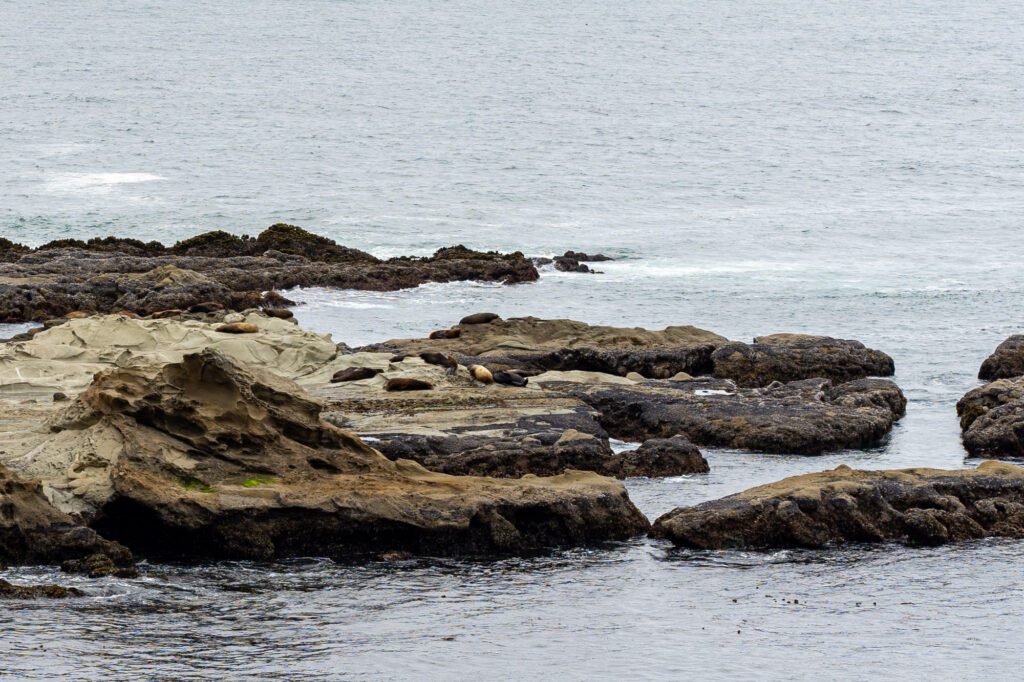
Bandon Beach & Bullards Beach: Bandon’s two main beaches are on either side of the inlet of the Coquille River. As you come to the beach, you’ll notice the sandy beaches of the northern and central coast are starting to give way to the rocky, rugged beaches with picturesque sea stacks that you’ll find on the southern coast, particularly in the Samuel H. Boardman Scenic Corridor (your next stop). Because they’re separated by the river, it’s actually not that easy to get from one to the other – it takes 15 minutes to drive between them. If we have to choose, we choose Bandon. Don’t miss Face Rock Scenic Viewpoint (and Devil’s Kitchen, which is 5-7 minutes south by car).
Bandon Rain: Bandon Rain is the local cider company in Bandon! Their cider is good, and you can only get it on tap at their taproom or on tap at a very select few places in Oregon.
Places to Stay near Coos Bay
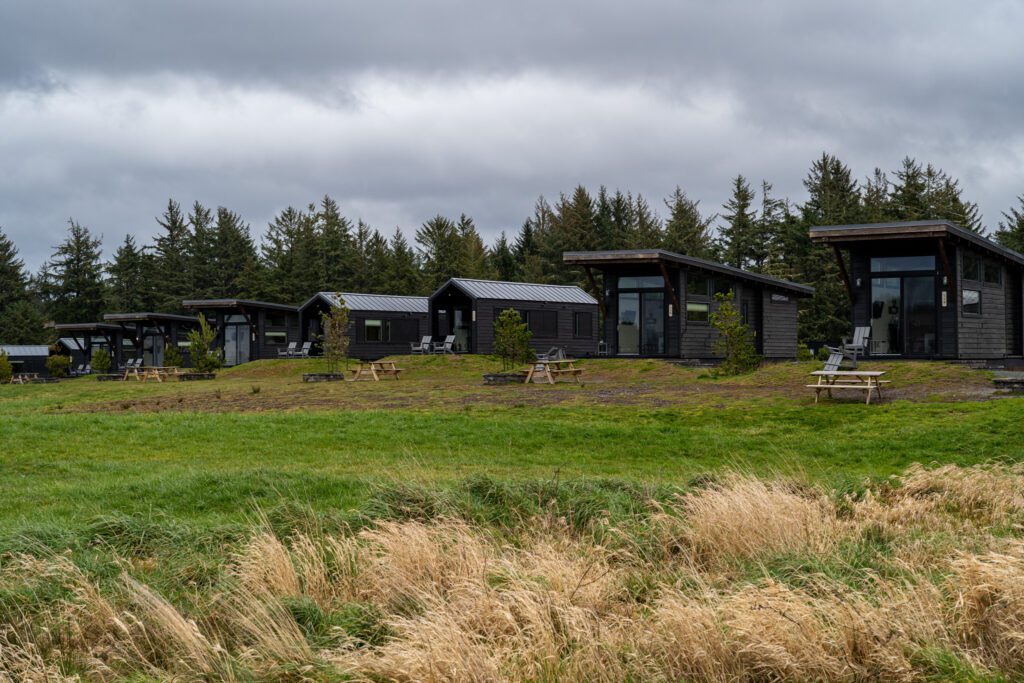
We absolutely love the modern cabins at Bay Point Landing, where we spent a few nights of stormy winter weather on our latest drive down the Oregon Coast. They’re a little on the pricey side, but we think the waterfront views, comfortable beds, and modern amenities (they have a bocce ball court!) make it worth it.
They also have Airstreams and RV sites, though we can’t imagine the RV sites are particularly nice given that it was constantly windy. Like, really windy.
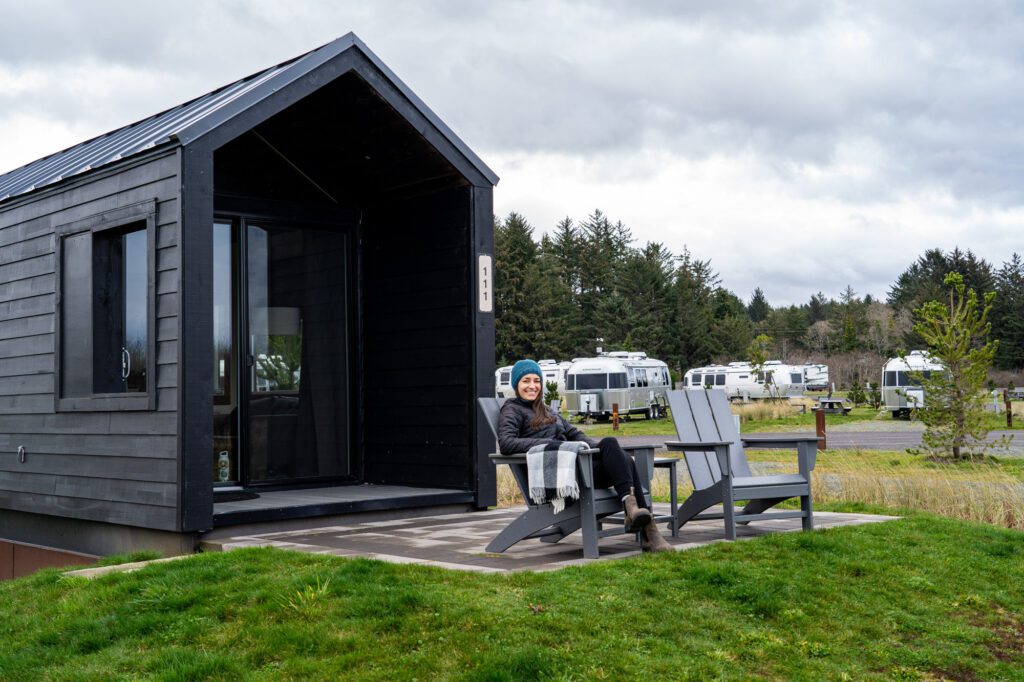
It’s just outside of Coos Bay, along the same road that takes you to Sunset Bay State Park.
If you’re not into that idea, then you should stay in Bandon. There are a bunch of highly rated hotels in Bandon, but we think the Lamplighter Inn looks really nice. The Table Rock Motel also looks great, and it’s walkable to Bandon Beach.
Port Orford to Gold Beach
For this stretch, we’re going to cover a huge swath of coastline in one section. Sure, we could break it up and make each town into its own section, but there would only be a couple of sentences on each place, which doesn’t feel like the right way to do it.
Instead, we’re going to give you our favorite stops from Cape Blanco State Park to the northern end of Samuel H. Boardman Scenic Corridor, in the order in which you’ll encounter them on your road trip.
Blacklock Point: It might feel like you’re not going the right way at the beginning of his hike, as you’re walking along a barbed wire fence next to an airport, but as soon as you get out to Blacklock Point and you find the stunning rocky beach that you have all to yourself, you’ll understand why we included this stop. You can continue on to Floras Lake, but we think the best part is the beach at Blacklock Point. More trail information, including recent trail reports, here.
Cape Blanco State Park: Just south of the trailhead for Blacklock Point you’ll find Cape Blanco State Park. This is another of the Oregon Coast’s best lighthouses. You can drive basically right up to the parking lot, so there’s not a whole lot of hiking or exploring to do here, but it’s worth a stop. If you want to get out to the beach on the south end of the lighthouse, there’s a short trail that leaves from the parking lot heading south.
Port Orford Heads State Park: Worth a quick stop in Port Orford to walk the short trail with great coastal views.
Humbug Mountain State Park: Another amazing Oregon State Park! Two things here. First is the tough climb up to the summit of Humbug Mountain (trail guide here), which is hard but worth it for the views at the top. After your hike, head under the highway to the other side to get out to this beach (we can’t find a name for it!), which is accessible from a trail at the western end of the campground. It’s a great beach! We camped at Humbug Mountain on our first trip up the coast, and spent a beautiful sunset out there.
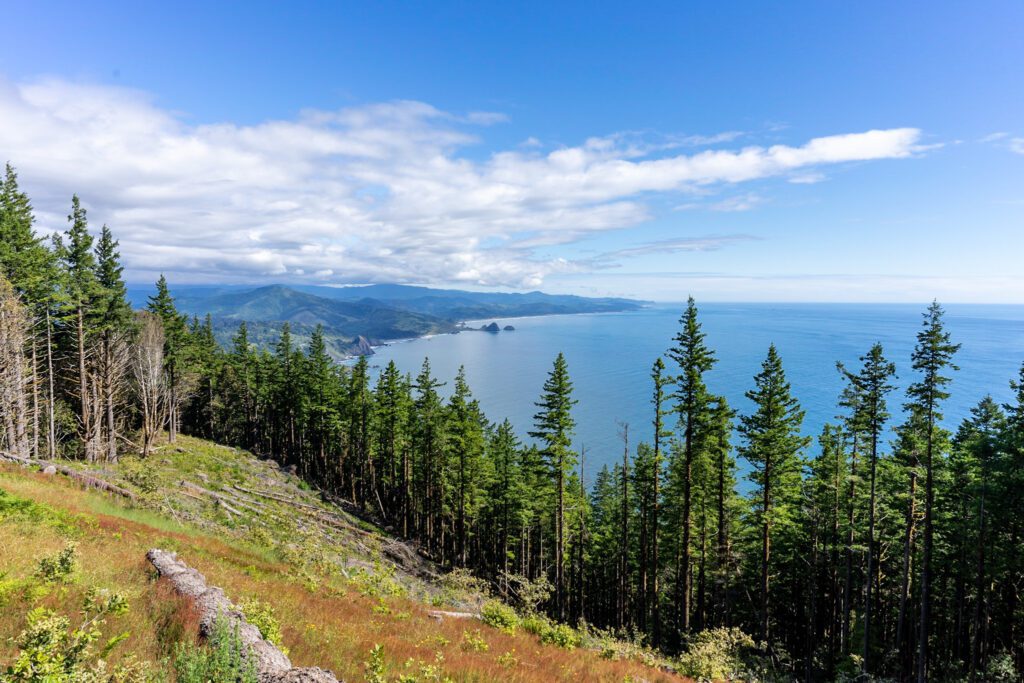
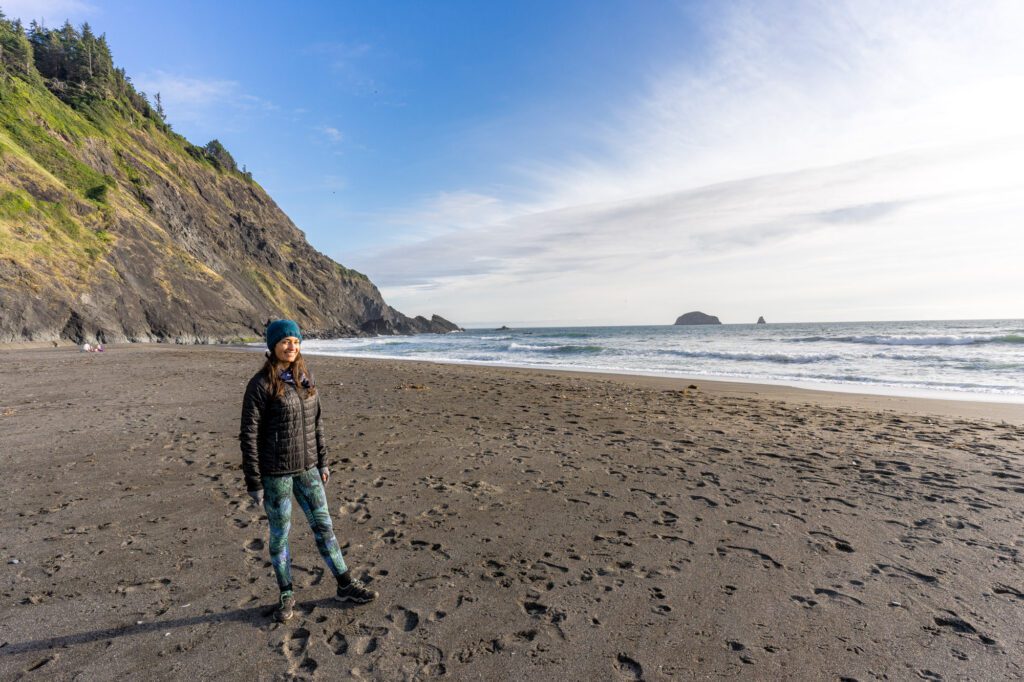
The Samuel H. Boardman Scenic Corridor
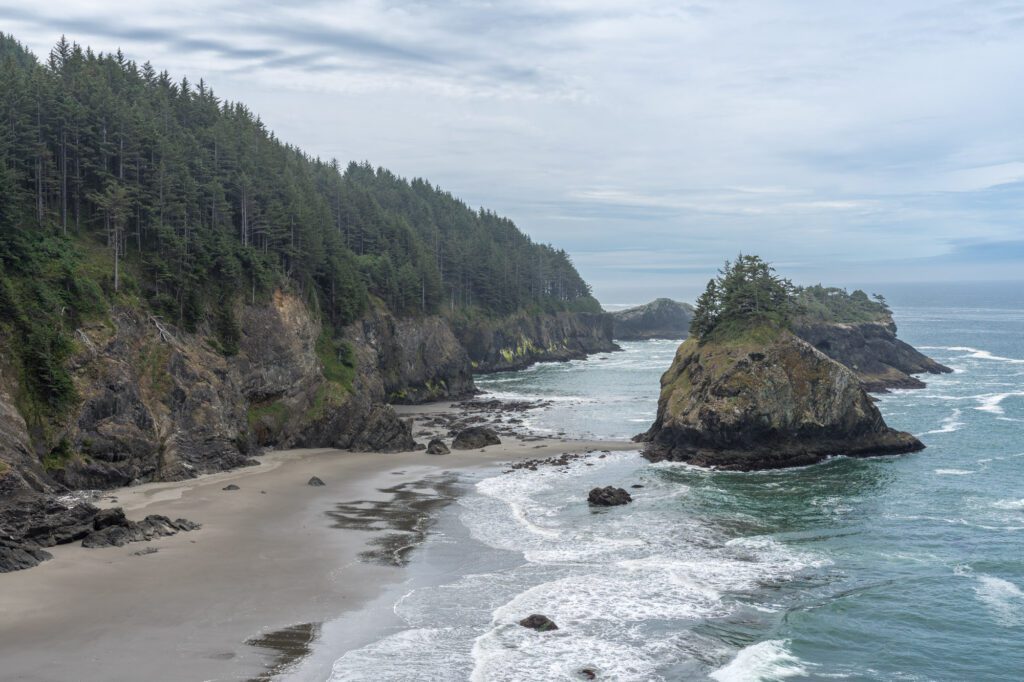
This is, without a doubt, our favorite stretch on the entire Oregon Coast. At least when it’s not stormy and quite literally raining sideways with thick coastal fog, which were the conditions on our latest trip in the dead of winter (cool in a different way, I guess).
The Samuel H. Boardman Scenic Corridor runs from the town of Gold Beach at the north end to the town of Brookings, which is essentially on Oregon’s southern border with California.
It’s named after the first superintendent of the Oregon State Parks system – Samuel H. Boardman – who was almost single handedly responsible for acquiring the land for this stretch of protected coast.
His pitch for a national park on the Oregon Coast was shot down by the powers that be, but he got a deal done for this piece under the state parks system.
It’s everything we like about the southern Oregon coast (and the northern California coast, for that matter) encapsulated in one hour-long stretch of driving. Not including stops, and there will be a bunch!
Here are our favorite stops, again organized from north to south. Most of these are either very, very short hikes, or hikes that are three miles or less. You can easily get a few of them under your belt without doing too much hiking. Here’s a nice map and brochure with more information.
Cape Sebastian: This was the first hike we ever did on the Oregon Coast, and what an introduction it was! This hike has everything that we love about the Oregon Coast – huge groves of sitka spruce trees, rugged, rocky coastline, and fresh sea air. It’s an easy 2.7 mile hike, but you hike downhill on the way out, which means an uphill climb on the way back (which includes a not insignificant number of switchbacks).

Secret Beach: The best beach on the Oregon Coast? But it’s not quite those big sandy beaches you find at places like Cannon Beach and Fort Stevens State Park. Instead, it’s a short little hike off the side of the highway that takes you down to a, well, secret beach that is best explored at low tide (check them here).
Natural Bridges: Not very far down the road is another great viewpoint. We’ve seen people hike all the way down to stand out on the natural bridge, which is insane and you definitely shouldn’t do that. Instead, admire the view from the viewpoint, and if you’re feeling adventurous, take the established trail down and to the right from the parking lot, which takes you down to a great view of the rock formations. It’s a little slick after rain, so make sure you have proper footwear.

Indian Sands: A short and sweet loop that includes some climbing on sand, cool coastal views, and should only take about half an hour or so.
Whaleshead Beach: Just south of the Indian Sands trailhead, this beach has a rough road leading to it, so if you’re concerned about clearance, you can walk down in 10-15 minutes. At low tide, there are some cool tidepools that form in the rocks with all sorts of sea life.
Cape Ferrelo: The end of this hike, which takes you out to the tip of Cape Ferrelo, is pretty cool. It’s short, and well worth the stop for, you guessed it, more amazing coastal views out over Lone Ranch Beach. You can also hike up to the head from the beach, which is actually what we did. Park here and walk up the trail on the hill to the right (or to the north).

What to Do with Even More Time on Your Oregon Coast Itinerary
But Matt and Alysha, I have than seven days, what should I do?
First, lucky you! Second, great question! With more than a week, we’d add time in places you’re already staying, and use that as a home base for exploring (rather than adding brand new places to stay).
We have some ideas because of course we do. Here are three places we’d add more time.
Cannon Beach: There are so many great hikes around Cannon Beach that we, being big hikers, would be happy with 2-3 days around Cannon Beach. If you’re not into hiking, then 1-2 is probably enough.
Newport: Newport is the biggest town on the central / southern Oregon Coast, and has some great breweries, restaurants, and stuff like that to occupy your time. Plus, the entire stretch of coast from Depoe Bay down to Cape Perpetua is downright gorgeous, and deserves more than just a drive by. Don’t miss the Hobbit Trail and Heceta Head Lighthouse just south of Newport!
Gold Beach / Port Orford: The southern coast is amazing, with sunny skies (or, more accurately, sunnier skies) and warmer temperatures than the northern part of the coast, but it’s a little harder logistically. It’s worth a solid 2-3 days if you have it to do some of the great hikes, drive Samuel H. Boardman Scenic Corridor (more than once, if possible), and let yourself be lulled into the slower pace of life down south.
It’s also worth spending the night in Brookings or across the California border in Crescent City to set yourself up for the big drive the next day.
The easiest way to get back to, well, anywhere really, is to head out to I-5 from the coast on 199, which takes you to Grants Pass.
The Best Time to Take an Oregon Coast Road Trip
The Oregon Coast is accessible year round, but your experience is going to vary wildly across the different seasons.
It’s also worth considering that the southern Oregon coast, known as the banana belt, is going to be significantly warmer and drier than the northern coast, which gets up into temperate rainforest territory.
We’ve been in the summer and the dead of winter, and they were both enjoyable, but different.
Summer brings the best weather on the coast. It will be sunny and warm compared to other parts of the year, but you may run into thick coastal fog in the earlier summer, which is pretty typical.
The downside of summer is the crowds – everyone and their mother comes to the Oregon Coast from all over to experience its beauty, and as a result trailheads are packed, campgrounds are competitive, and you’ll want to book accommodations well in advance.
Spring and fall are fairly similar. They’re going to be a little cooler and grayer than summer, and the weather will be more unpredictable.
Expect some days of sun and blue skies, and some days of driving rain and wind. Crowds are thinner, camping is less competitive (also less enjoyable), and it’s a little cheaper.
Winter is all about the stormy vibes, perfect for sitting next to a fireplace and listening to the rain careen off the roof.
You’ll get some nice sunny days, but they’ll be biting cold (it was below freezing last time we were on the coast, but the sun was out!).
The majority of the time, though, it will be gray and drizzly. Sometimes, it will be windy and raining sideways, which is by far our least favorite form of weather. Plan to be wet when you’re hiking, and expect deep mud on basically every trail.

